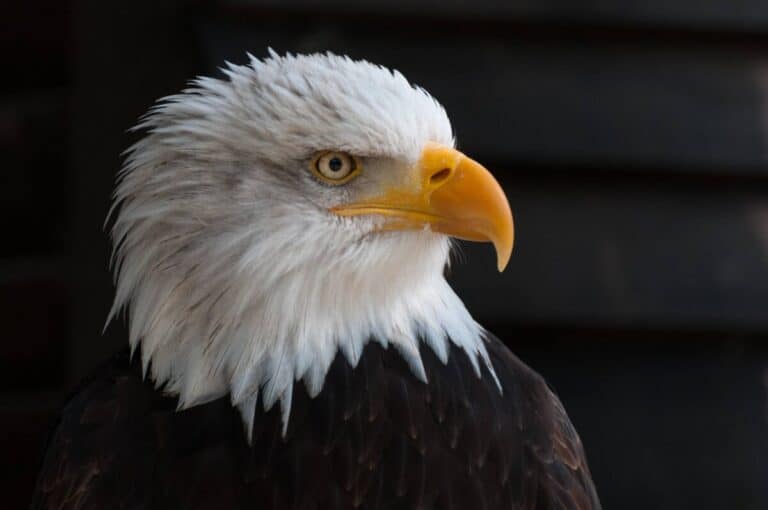Why are Birds Not Coming to Feeder? Here are 29 Reasons Why!
We’re reader-supported; we may earn a commission from links in this article.
I know how it can drive you crazy not to see any birds coming to your feeder.
Many things can go wrong, resulting in them not coming to your feeders!
I was really curious about this, so I did some crazy amounts of research to find out all the answers for you!
I’ve managed to find a whopping total of 29 reasons why birds won’t come to your feeder! 🐦⬛
Read on for more information!
1. You Set It Up During the Wrong Time of Year
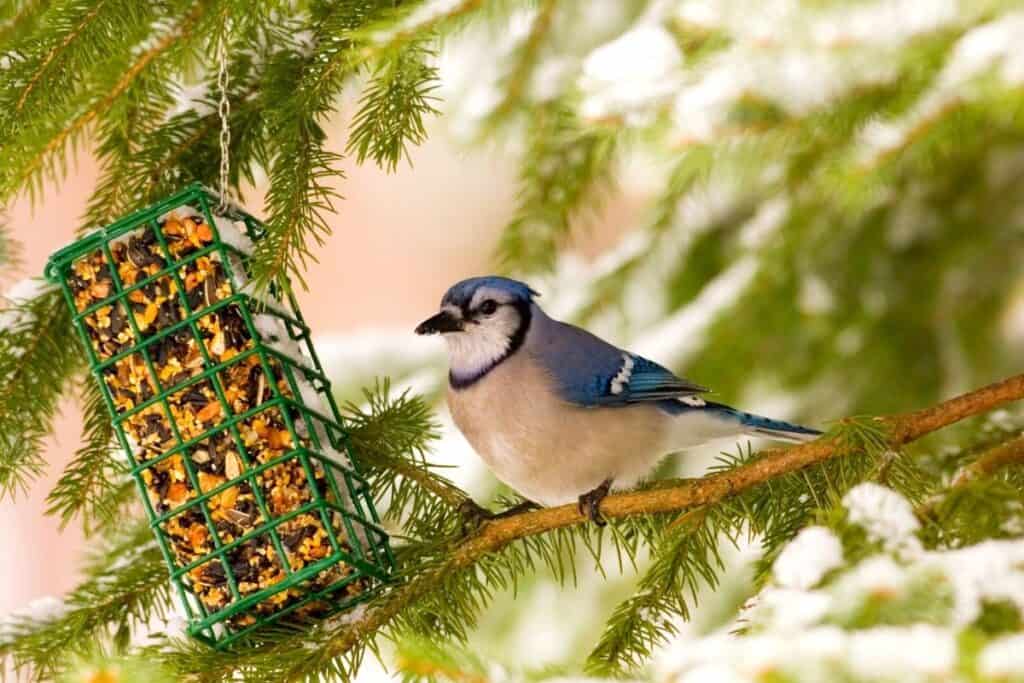
One of the most common reasons why you wouldn’t see birds appearing in your backyard is this: you set it up at the wrong time of year!
The time of year when you will see more birds is during the springtime (April – June) if you live in the northern hemisphere! This is when they will return to prepare for the mating/nesting season.
Now, while keeping that thought in mind, you would think to start setting up your feeders during April to June, right?
Well, that might work, but you have missed out on a really good opportunity to provide food for those birds that stayed behind during winter and those that arrive in the early migration months of February and March!
Why feed birds during the winter too? Sounds a little contradicting.
But in reality, it’s the opposite.
Here’s 4 Ways Birds Know When To Return After Winter! Check out this article to learn and recognize when they return after the winter period.
Food found during the wintering months (Dec – Feb) is extremely scarce and birds need food more than ever!
By providing your bird feeder during the wintering months, resident birds (birds that don’t migrate away) will find your feeders, given the food scarcity in the challenging environment!
Read about why resident birds stay for the winter.
This produces a snowball effect (pun intended!) for when early nesting birds come over later and realize resident birds are already feeding on your feeders.
Essentially, they discover your feeder more easily!
So here’s my recommendation: Start setting up your feeders by winter if possible! If you’re not able to do so, just start whenever the season it is you are in now! It takes patience to see birds feeding on your feeder.
Read more about when birds lay eggs during the year.
2. You Look at Feeders During the Wrong Time of Day
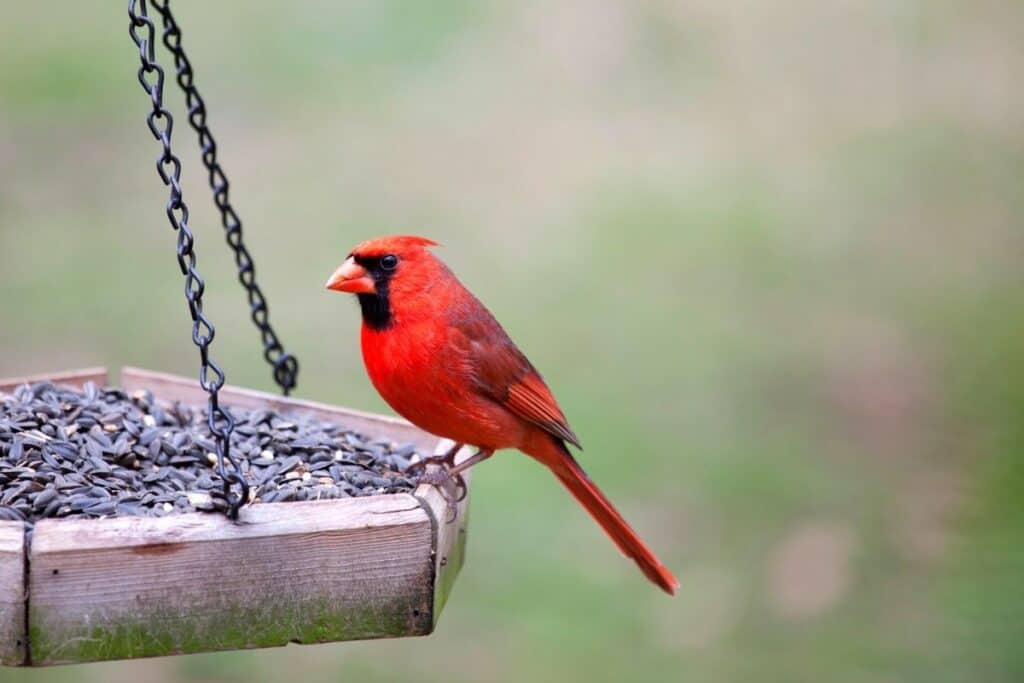
As a successful bird feeder/ bird feeding setup is very subjective according to the time of day, you need to note not to look at your bird feeder during a non-peak time and call it a failure!
When it comes to feeding birds, it’s a matter of timing.
Birds are more actively feeding at certain times of the day than other times!
I did my analysis of freely available citizen science data and came up with the answer below:
Birds feed at all times of the day. Birds feed the most in the late mornings at around 10 AM and much lesser during evening time and night time. The time of day birds feed depends on the seasons, the weather, and whether the bird is diurnal or nocturnal.
Read more on how I derived the answer and more juicy details and intricacies of what time of day birds feed.
3. Your Bird Feeder Needs Time to be Found by Birds
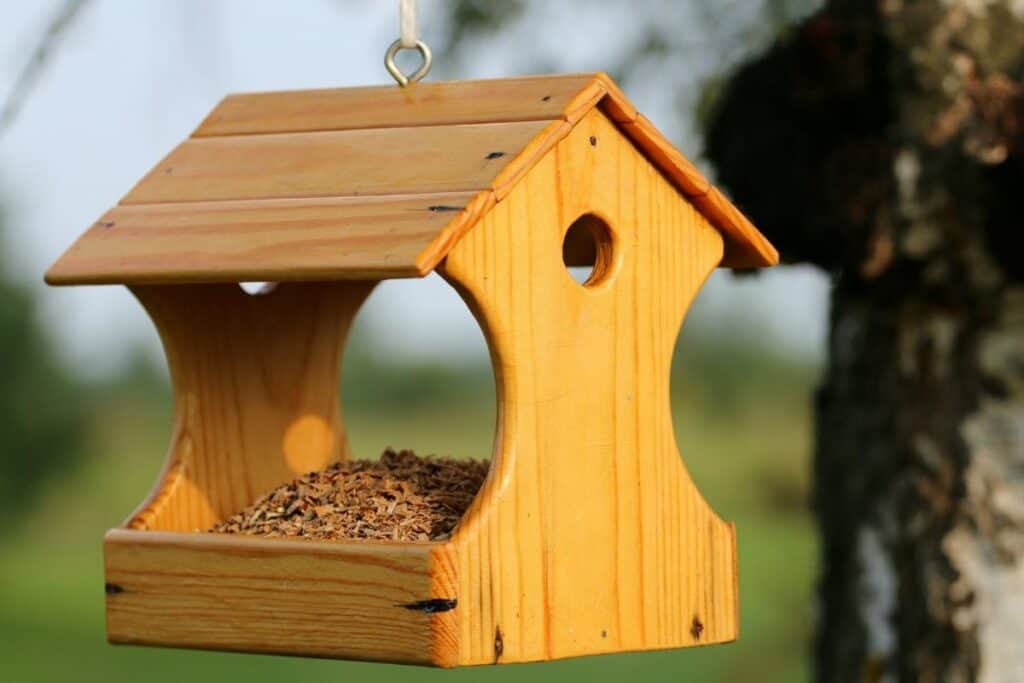
Here’s the gist: birds take time to find your feeder!
Simply leaving your feeder out for a short while won’t work. You need to have the patience to see the results (beautiful and colorful birds!)
I did my own study on this topic and found this to be the best answer:
Birds take about ten days to find a new feeder. Birds typically take 5 – 18 days to find feeders, depending on the feeder location, the local bird species, the safety of the environment, and the time of day. For example, birds in Utah take 18.8 days but birds in Arizona take 6.2 days to find new bird feeders.
Learn how long it takes for birds to find a new bird feeder.
If you are living in the US, you can even interact with the graphs I created to see how long it took for people to see the first birds at their feeders!
Check it out!
4. Your Bird Feeder Has Too Many Potential Predators Nearby
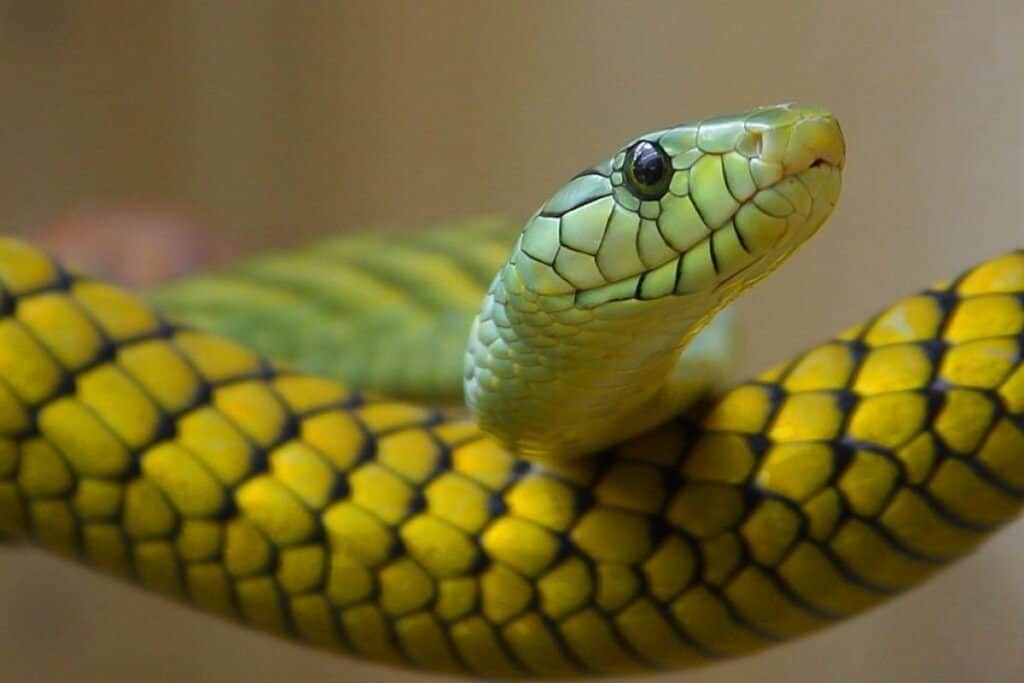
Birds are extremely skittish creatures that will take flight if anyone comes too close to protect themselves from predators.
Potential predators of birds include:
- Snakes
- Hawks
- Eagles
- Raptors
- Scavenger animals
As birds are extremely sensitive to the presence of such predator animals, they would not approach a bird feeder that has any of these in the area.
Of course, you can’t really do much about the natural predators in the area. But thankfully, these predator birds are not always present so you can just wait patiently for them to leave.
Please do not harm any wildlife in order to feed wild birds!
5. Your Bird Feeder is Placed Too Close To Natural Foliage Nearby
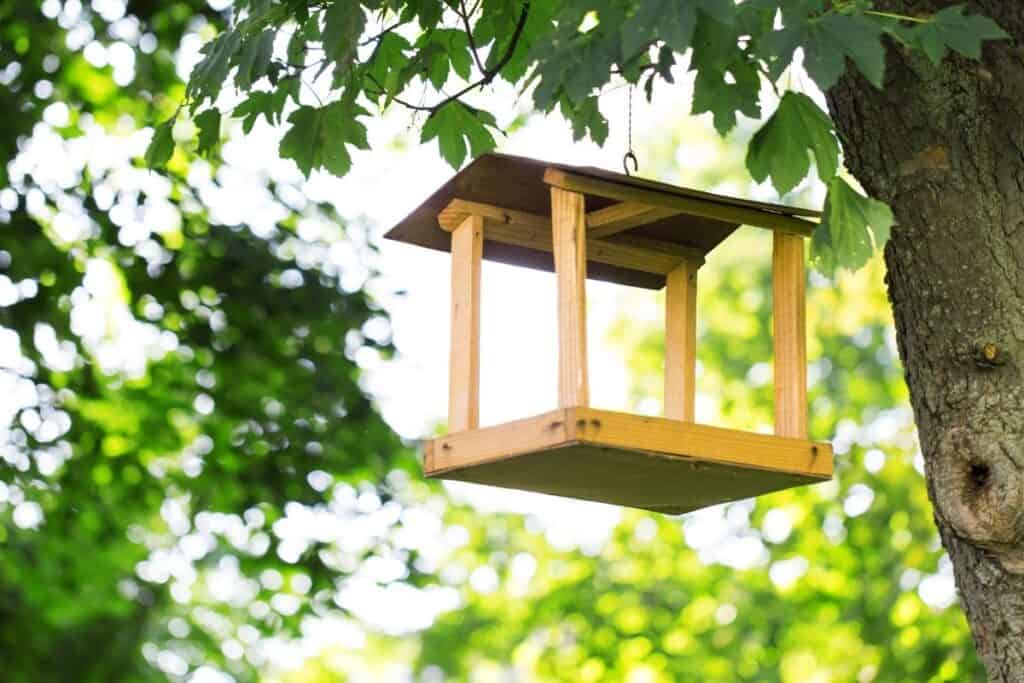
Bird feeders are meant for birds to feed and, as such, need to be a safe place for birds to eat in peace!
The number one concern in a bird’s head during feeding is this: Am I In Danger?
As such, if your bird feeder is too close to natural foliage nearby, this may provide access routes for predators to reach the birds.
For example, if your bird feeder is too close to a tree, snakes can easily climb the tree, reach down, and attack the birds feeding at your bird feeder.
Any smart bird will not even go near that feeder!
(Plus, if you put your bird feeder too near a tree, that’s unhygienic too because lots of debris from the tree can fall into the feeding tray and contaminate the bird’s feed.)
As a general rule, you should shift your bird feeder and its stand to somewhere at least 6 – 8 feet away from any natural foliage!
As this is only a rough distance you can follow, move it as you deem it far enough so that other animals can’t reach it from the trees.
6. Your Bird Feeder Does Not Have Natural Surroundings in the Vicinity
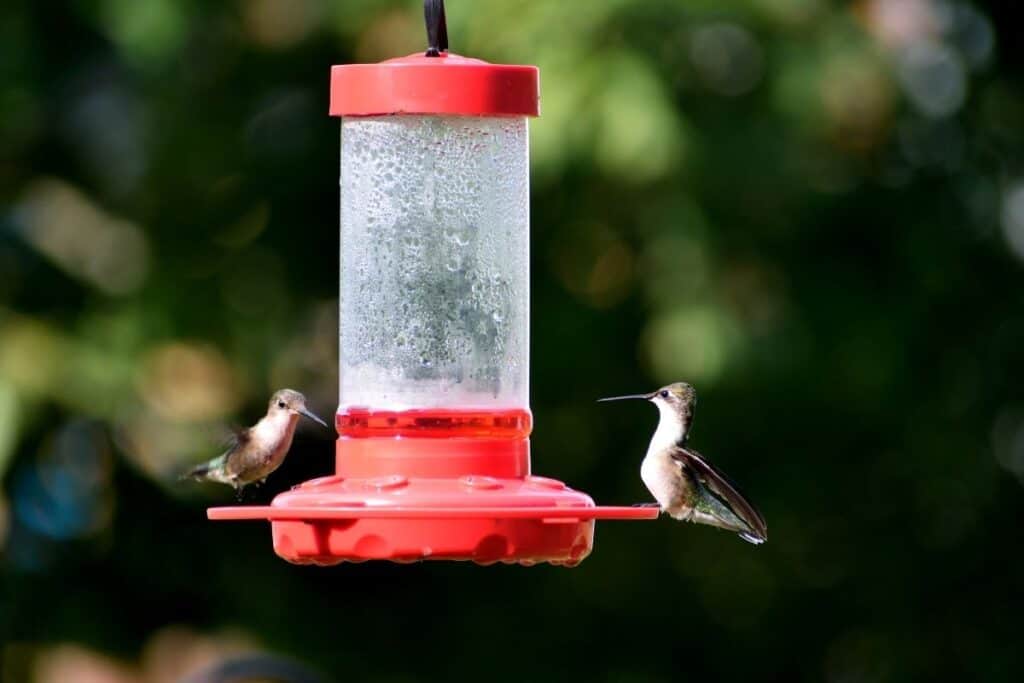
While you don’t want natural foliage to be near your feeder, you’ll still want to have natural surroundings in the vicinity.
This means things like:
- Plants
- Shrubs
- Bushes
- Flowers
- Grasses
- Trees
It always helps to plant fruiting trees and shrubs, which will attract birds to your backyard naturally!
Then while there hanging out in your backyard, they’ll notice the presence of the abundance of bird feed in your bird feeder.
These natural surroundings will provide a protective cover for birds to hide while they are taking a rest from feeding.
Of course, planting these takes time and effort, so you need to start learning and acting on them as quickly as possible!
A few good trees you can consider planting:
- Elderberry
- Hawthorn
- Crabapple
You can also consider planting flowers and shrubs that will attract bugs, which will, in turn, attract birds that eat bugs
The key idea is this: to build your own “mini-ecosystem” in your backyard where birds love to hang out and eat at your feeder!
7. Your Bird Feeder is Either Too High or Too Low
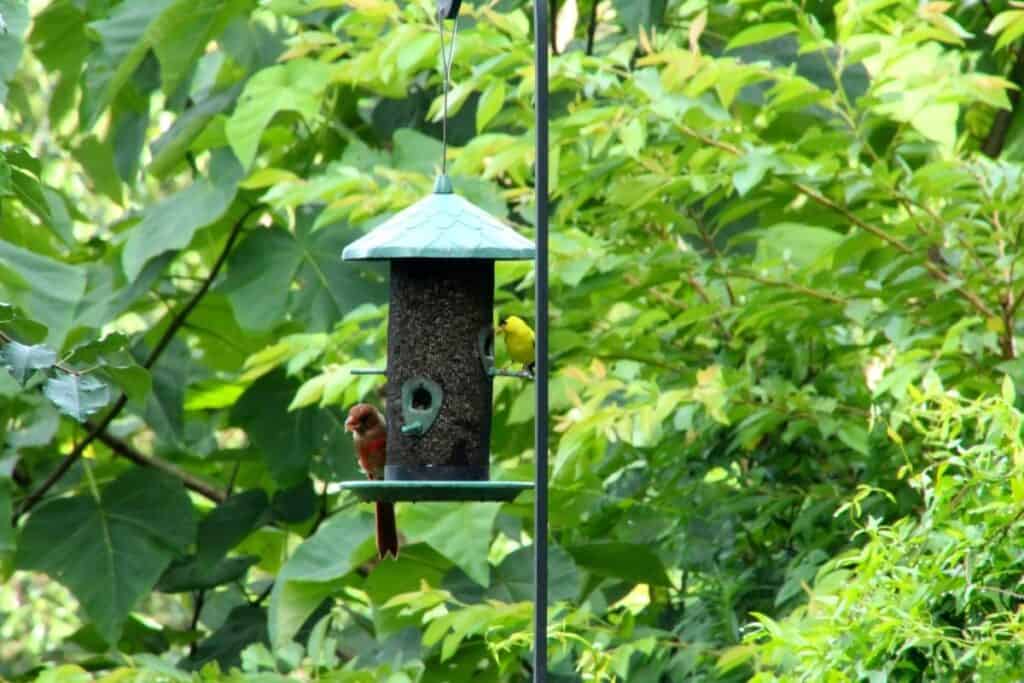
Here’s a fun fact: different types of birds feed at different heights!
As bird species have different diet preferences, the height they usually hang around will always be different.
For example, sparrows are ground feeders that feed on grains, seeds, and insects on the floor. As such, they typically would not feed on feeders that are too high up for their preference!
Some birds just choose to simply hang around nearer to the ground because they like it and have their nesting site at around the same height.
Here are the different bird species and the heights you should hang feeders for them to feed at:
| Bird Species | Height | Height Reference |
| Woodpeckers | 6 – 10 Feet | Top portion of trees and canopies |
| Orioles | 6 – 10 Feet | Top portion of trees |
| Chickadees, bluebirds, titmice | 5 – 7 Feet | Mid portion of trees |
| Cardinals, finches, hummingbirds | 3 – 6 Feet | Low portion of trees and bushes |
| Sparrows, mynahs, pigeons | 1 – 3 Feet | Ground |
Based on the table above, you need to check the type of bird species that’s common in your area, then plan out your bird feeder height to suit them. That way, you’ll place the optimum height for birds to feed at.
You can start by looking at this link to FeederWatch where they provide the top 25 birds that you’ll most commonly see in your state. (You can select your state, and it’ll spit out the results)
Then, you’ll need to head over to this tool by FeederWatch again to learn more about the bird species.
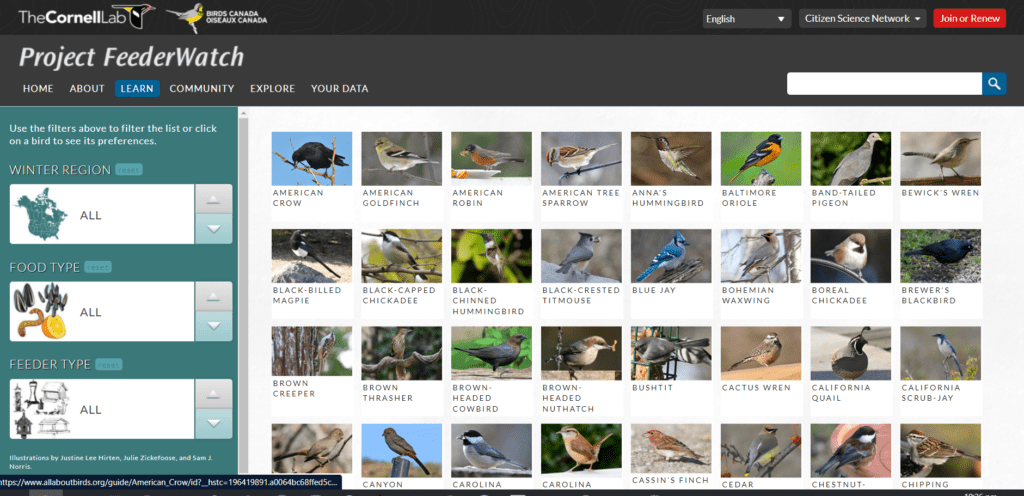
Pay attention to this: After selecting a bird of choice by clicking on its picture, scroll down to the bottom and look for the feeder type.
This can give you a hint on whether the feeder needs to be hung or mounted on a pole.
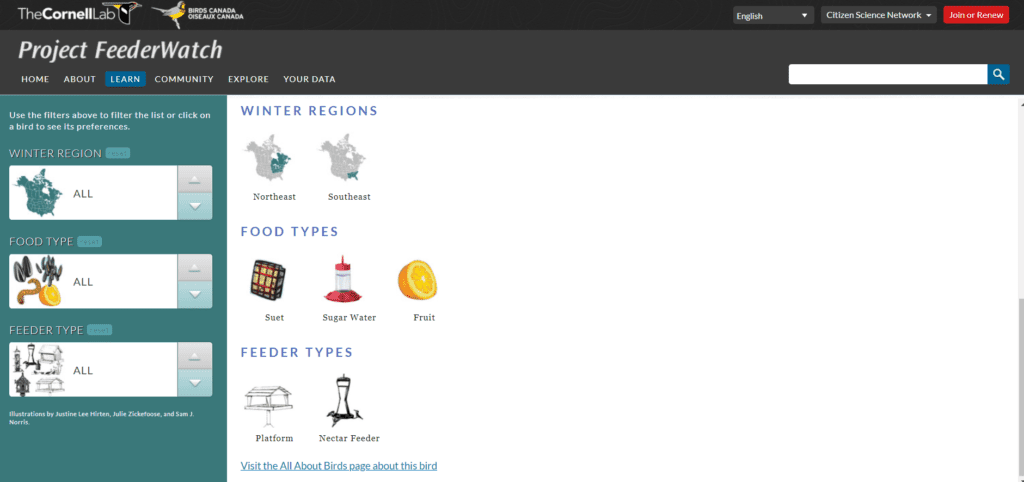
8. Your Bird Feeder Has Too Few Perches Nearby
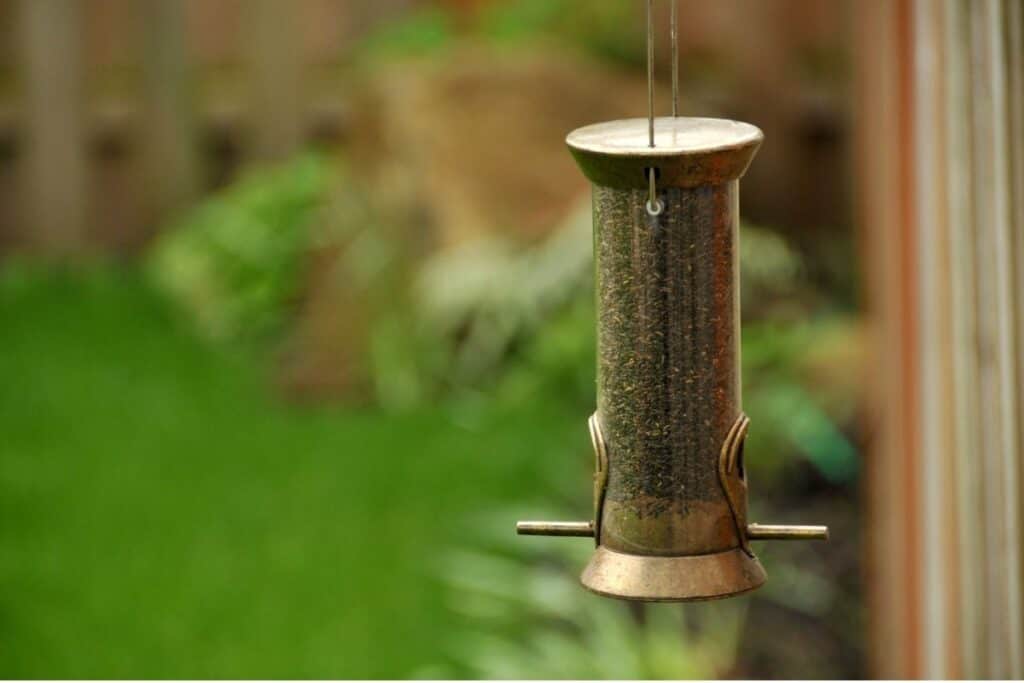
Bird feeders need to be catered for birds, and having no perches nearby for birds to rest and hang out is like having no seats around when you’re waiting your turn at a clinic.
You would get really tired and frustrated!
If you get a bird feeder pole like the one below, birds are able to perch onto other perches of the pole to approach the feeders:
You can purchase a feeder pole like this through this link.
This feeder pole works well if you want to have multiple feeders too!
Read more on how many bird feeders you need.
9. Your Bird Feeder is Overwhelmed by Squirrels
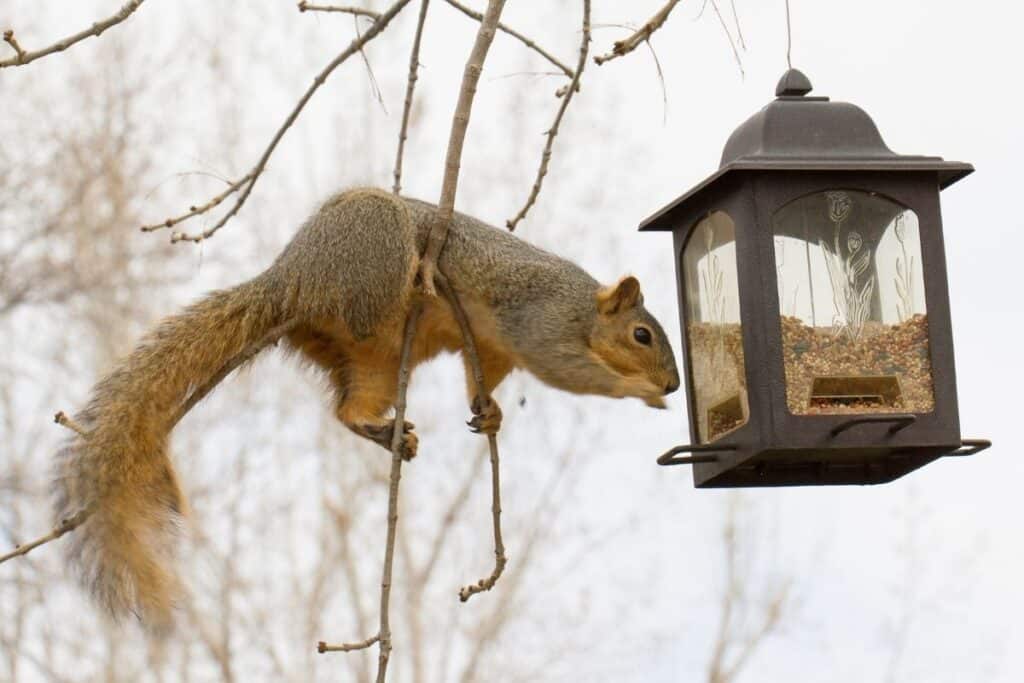
If you’ve had any experience at all feeding birds, you’ll know that squirrels are our no. 1 enemy!
That’s not to say that I don’t like squirrels at all; they are actually quite cute sometimes.
But squirrels tend to dominate feeders often because of their abundance of bird seed. When birds notice the presence of squirrels, they tend to be scared off really easily.
Just like that, your bird feeder is now a squirrel feeder!
There are some very practical steps you can take to deal with squirrels in your yard, but I’ll recommend one that works really well.
Most squirrels can access feeders because they climb an easily climbable pole or jump across a gap of up to 4 – 5 feet from a nearby tree.
To prevent this from happening, you can set up a squirrel-proof feeder and a squirrel baffle at the bottom of the pole.
I’ll show you some recommended products below:
With these 2 products working in tandem, squirrels won’t be able to climb up the pole due to the baffle, and won’t be able to eat off the perches of the feeder because its weight will cause the opening to close.
Check them out if you have a squirrel problem!
10. Your Bird Feeder is Dirty and Unpleasant to Birds
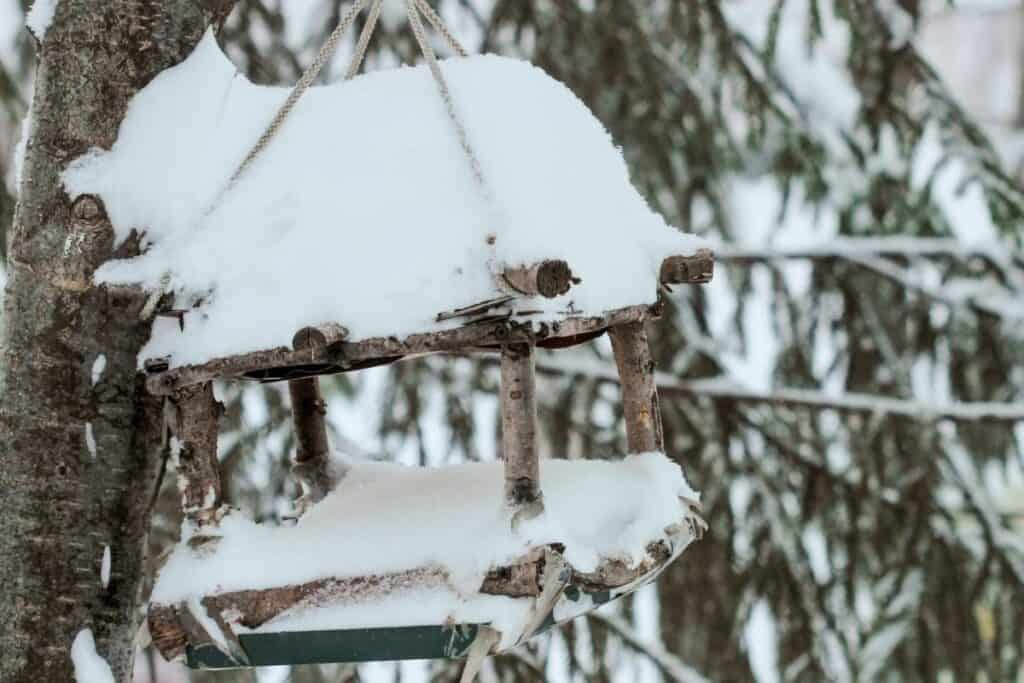
Birds not coming to feeder?
If you’ve left your feeder out for a while now, the seeds and feed stuck in it can get quite moldy and nasty.
If you notice the feeder be very dirty, you should clean it immediately rather than wait for the birds to disappear or for the feed to finish.
Birds can tell if the feeder is smelly and uninviting, and will be less likely to visit your feeder.
They may even take a mental note not to come back to a dirty feeder.
Cleaning it regularly also has other benefits.
It ensures that the bird feed is safe for the birds. By cleaning it up regularly, you’ll prevent the spread of nasty diseases that can spread among birds and even to you!
Birds, for example, can carry Salmonella bacteria and pass them to humans, causing infections. This was the case during an outbreak in May 2021 announced by the US CDC.
US CDC recommends cleaning your feeder and any bird bath at least once a month.
You must clean it more often if it collects more bird poop and debris.
Don’t touch any wild bird with bare hands!
11. Your Bird Feeder is Painted in the Wrong Colors
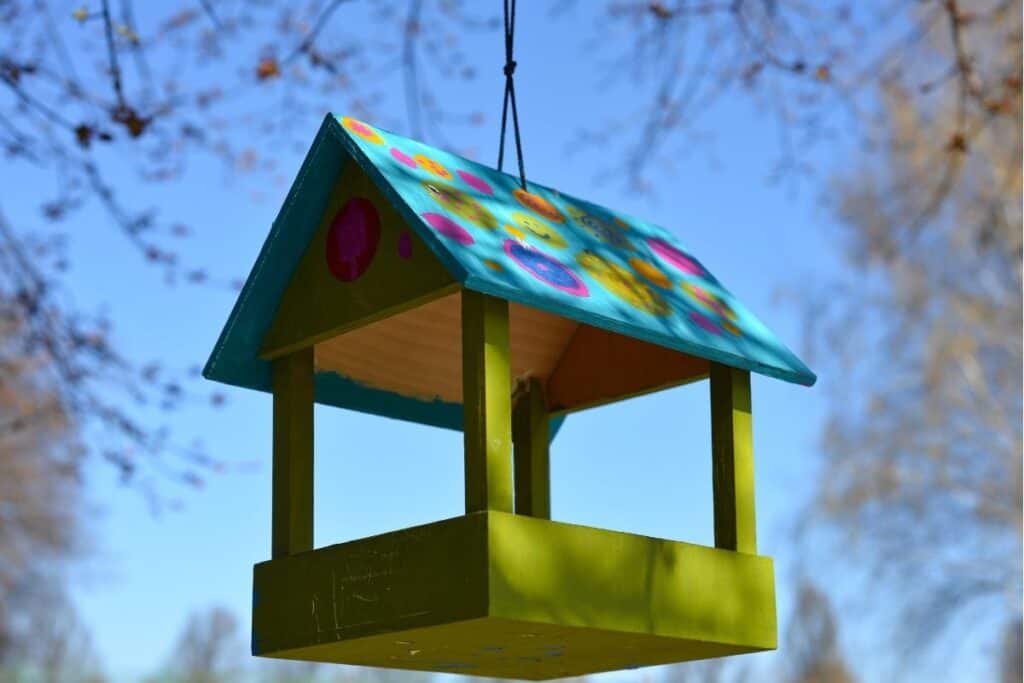
Birds are VERY visual animals with tetrachromatic vision because they sacrifice their poorer sense of smell.
As a result, they become very sensitive to certain colors that may represent natural food sources.
So if you’ve painted your bird feeder with the wrong colors for the species that you’d like to attract, you’re really missing out!
Here’s a summary of what I mean:
Bird feeders should be painted with any bright or primary colors. These colors include red and pink to attract hummingbirds, orange to attract orioles, blue to attract bluejays, and yellow to attract goldfinches. Drab camouflage colors like green can attract skittish birds. White scares birds away.
Here’s a quick guide on what color you can paint your (wooden) feeder:
| Bird Bath Color | Species Attracted | Reason | Amazon Link |
| Red and pink | Hummingbirds | Red and pink look like their food sources (beebalms, petunias) | Link (red) Link (pink) |
| Orange | Orioles (Baltimore, bullock’s, Altamira) | Attracted to their plumage color: orange | Link |
| Blue | Bluejays, bluebirds | Attracted to their own plumage color: blue | Link |
| Yellow | Goldfinches, warblers, hummingbirds | Attracted to their own plumage color: yellow | Link |
| Camouflage colors (brown, green, grey) | Skittish species (thrushes, ground feeders, doves) | Camouflaged patterns help skittish species feel safe | Link (green) |
| White | NONE | Birds interpret white as danger or aggression | – |
If you’re not looking to paint, consider getting the Kingsyard Birdhouse Triple Bird Feeder.
It’s colored bright red, which attracts many pretty birds like the Goldfinch, Cardinal, Chickadee, and Nuthatch.
Plus its drainage holes allow you to look inside the bird feeder easily, so you can top up your feeder when it runs out of bird feed.
It also helps keep the bird food fresh.
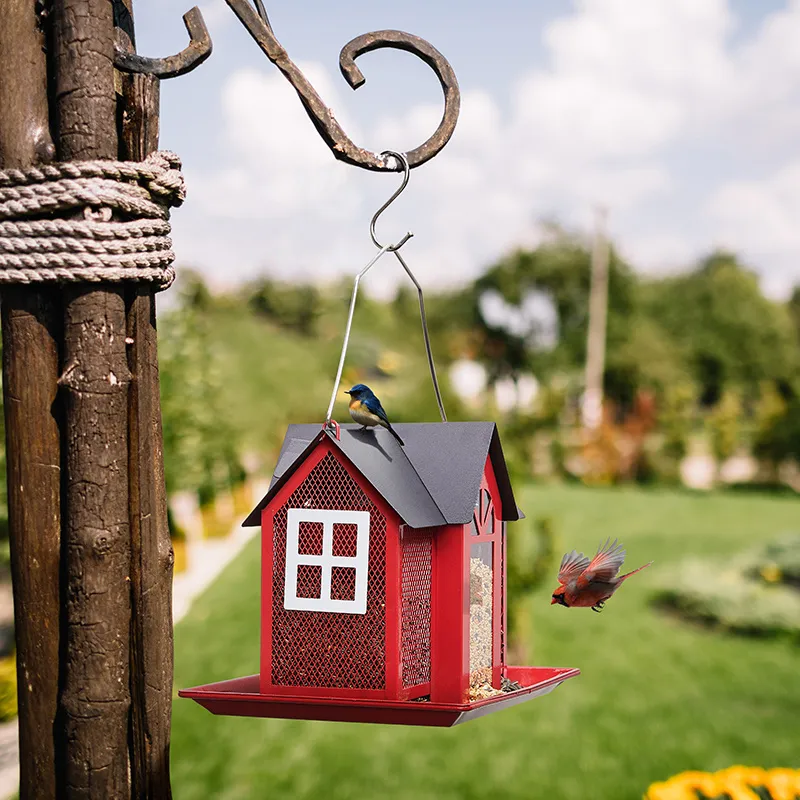
Moreover, all these paints recommended are safe for birds! Learn more about how to paint your bird feeder safely.
I recommend also learning what type of paint is safe for other bird items such as birdhouses, bird baths, and bird cages.
12. You Don’t Have A Birdhouse or Bird Bath In Your Backyard
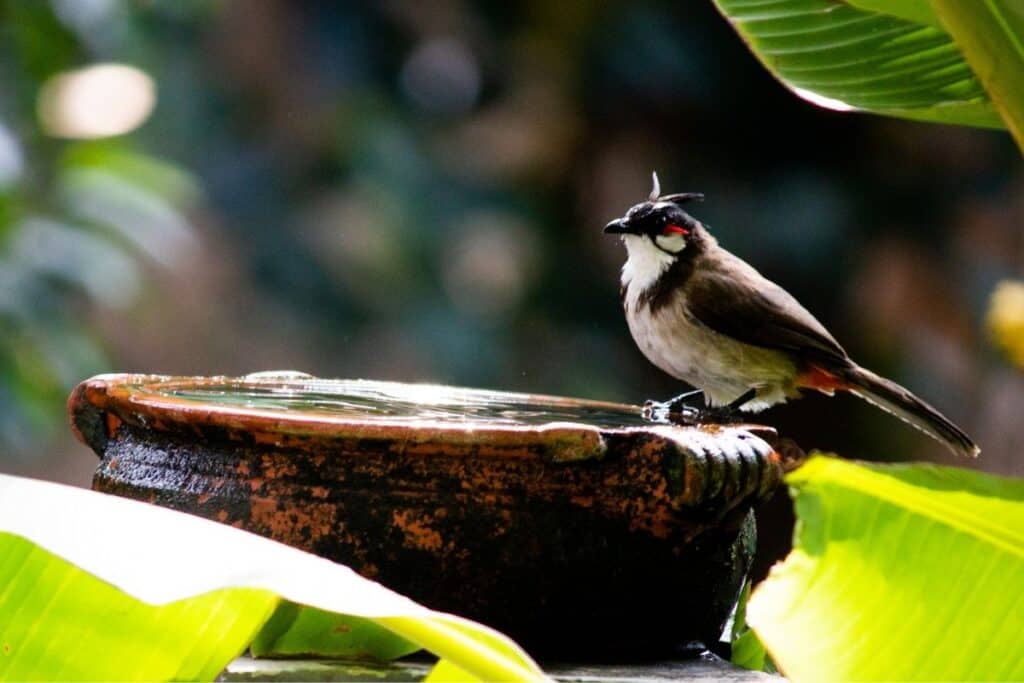
Providing a bird feeder is like having a restaurant for the birds in your backyard.
In the same way, having a birdhouse is like accommodation, and a bird bath is like a nice refreshing bathtub!
If you’re gonna spoil the birds silly with a bird feeder, why not consider setting up a birdhouse and a bird bath in your backyard?
Here’s why:
Firstly, birds first find a nice place to live by looking for attractive water sources such as bird baths which quench their thirst and for cleaning themselves.
Secondly, cavity-nesting birds will begin to look for a birdhouse to nest in to build up their young.
Having a birdhouse nearby helps them be naturally closer to your backyard where your feeders are.
This ensures that birds have a higher chance of discovering and feeding on your feeders since it is so close to where they nest!
13. Your Bird Bath and Birdhouse Are Wrongly Colored
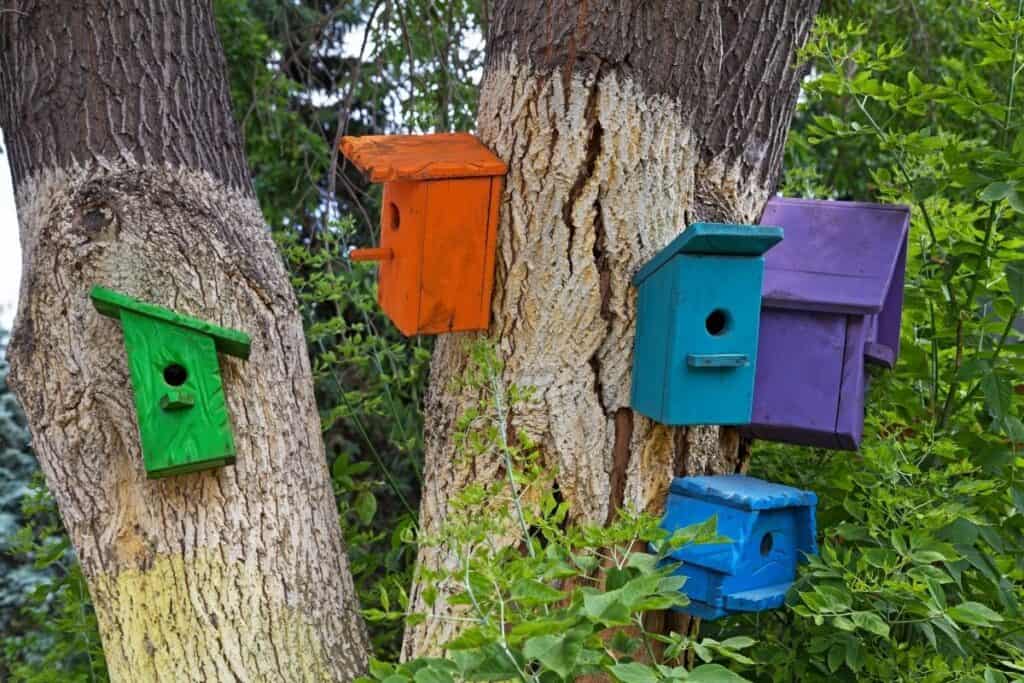
If you do have bird baths and birdhouses that accompany bird feeders, you also need to consider their colors for them to be effective as a complete package.
Based on my research, bright and primary colors attract birds to bird baths, and dull colors attract birds to birdhouses due to their ability to blend into the surroundings.
Bird baths, birdhouses, and feeders serve different purposes for birds.
Ideal colors for bird baths and feeders are very similar in that bright primary colors are great for them!
Learn more about bird bath colors and what kind of paint is safe for painting bird baths.
However, as birdhouses are like homes for birds to house their vulnerable young hatchlings, they need to be painted over with dull or camouflage colors not to attract too much attention from potential predators.
In summary, if birds are attracted to the colors of bird baths and birdhouses, they will be more likely to find your feeder!
14. Your Birdhouses and Bird Baths Are Too Close to the Bird Feeders
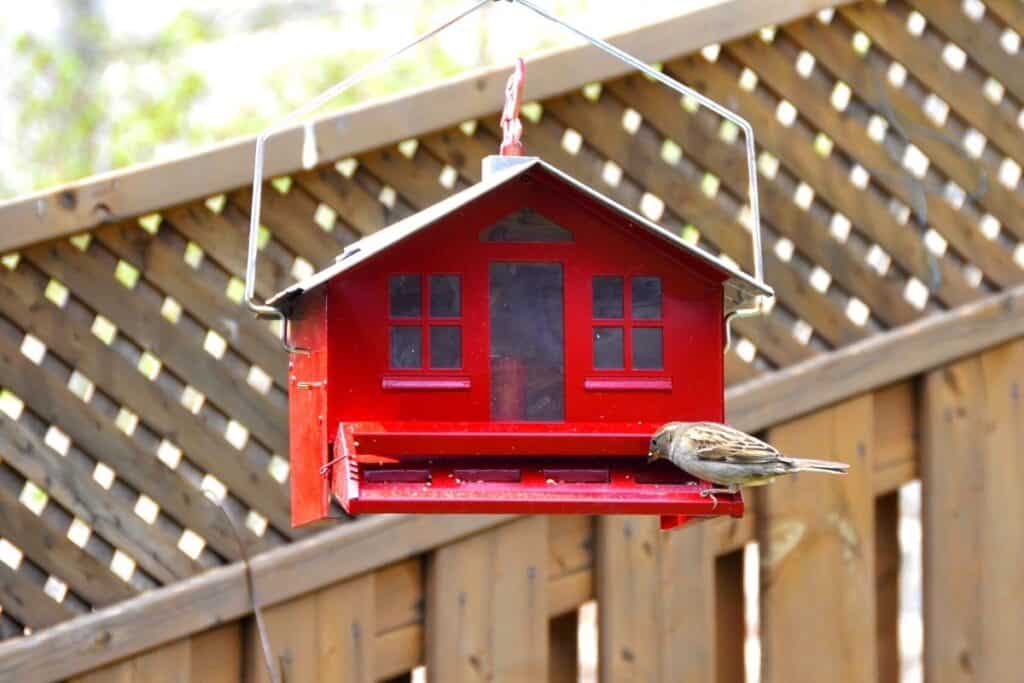
Bird feeders are places for birds to have a meal, so they shouldn’t be placed too close to other objects in your backyard, like a birdhouse or a bird bath.
Firstly, birdhouses are places for birds to bring up their young in a safe environment with less bird traffic.
Secondly, bird baths are water sources that attract birds to your backyard well, but they need to be quite far away from your feeders.
This is because birds tend to be really sloppy when eating the bird feed, so the debris, food scraps, and poo will enter bird baths and contaminate them!
So do be careful about this as it can cause great harm to the birds!
Personally, I recommend to have at least a 4 – 6 feet distance between your birdhouse/bird bath and your bird feeder.
As such, a good location for birdhouses is crucial to attracting birds!
15. You Don’t Have The Right Types of Bird Feeders
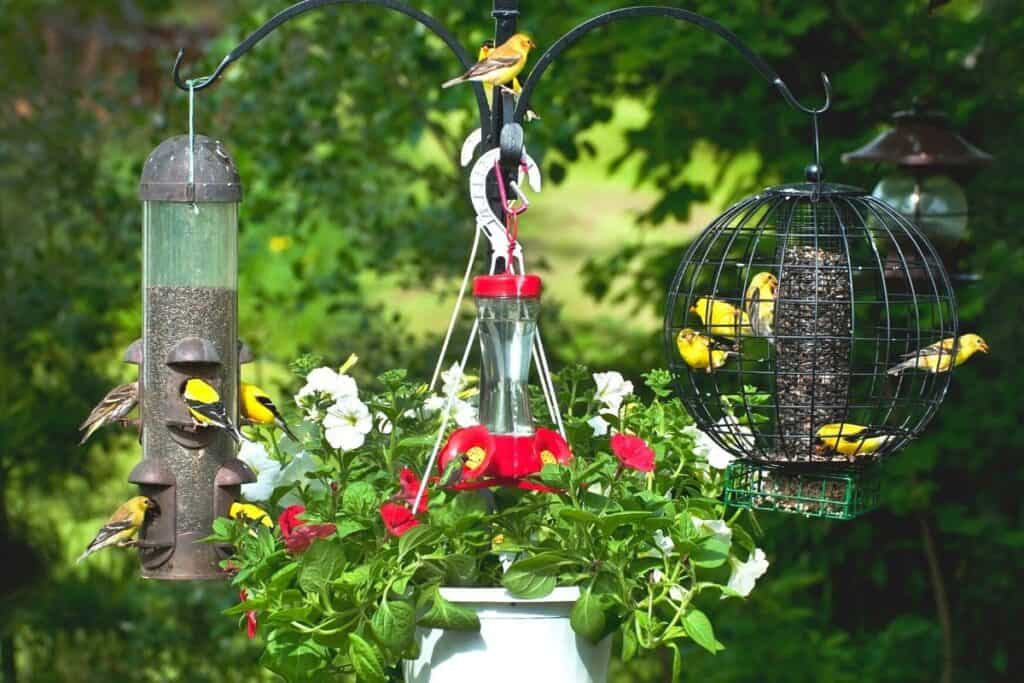
Birds have different diets and therefore require different types of bird feeders to store the different types of feeds.
In order to attract a larger variety of birds or the specific species in your area, you need to know what type of bird feeder you set up.
For example, suet feed can only be placed into a suet feeder, which is extremely popular among woodpeckers.
Here’s a quick summary table for you to refer to:
| Type of Feeder | Species Attracted |
| Tube Feeder | Goldfinches, jays, chickadees, finches, starlings, nuthatches |
| Platform Feeder | Sparrows, mynahs, starlings, doves, pigeons |
| Hopper Feeder | Most birds species attracted |
| Suet Feeder | Woodpeckers, nuthatches, flickers, starlings |
| Hummingbird Feeder | Hummingbirds |
Also, learn how many feeders you’ll need.
If you’re a beginner, start with one, and increase when needed!
Let’s cover each type of feeder really succinctly:
Tube Feeders
Tube feeders are probably the most common type of feeder that will attract the most type of birds.
What’s great about it is it usually has anti-squirrel mechanics built into it to prevent squirrels and other animals from feeding on the bird feed.
Platform Feeders
Platform feeders are meant to feed birds who are natural ground foragers. The flat platform allows them to feed off level surfaces, similar to how they usually feed on the ground.
Hopper Feeders
Hopper feeders are slightly similar to platform feeders in size, but they are usually built to allow for the automatic dispensing of feed over time so that the bird feed won’t be laid out like the platform feeders.
This prevents large birds from dominating the feeder.
Suet Feeders
Suet feeders contain suet only and are usually hung vertically.
These feeders attract woodpeckers the most because they are similar to how they find food out in the wild.
Hummingbird Feeders
Hummingbird feeders are special in that only hummingbirds can feed from them.
It usually contains sugar water. Only hummingbirds have beaks slender enough to feed from the openings of the feeder.
Therefore, if you have been using the wrong feeder to attract birds of a certain species, it’s highly likely that was the reason why birds didn’t come visit your feeder.
Knowing the right feeder to set up can bring in hordes of birds!
16. You Only Use One Type of Bird Feeder
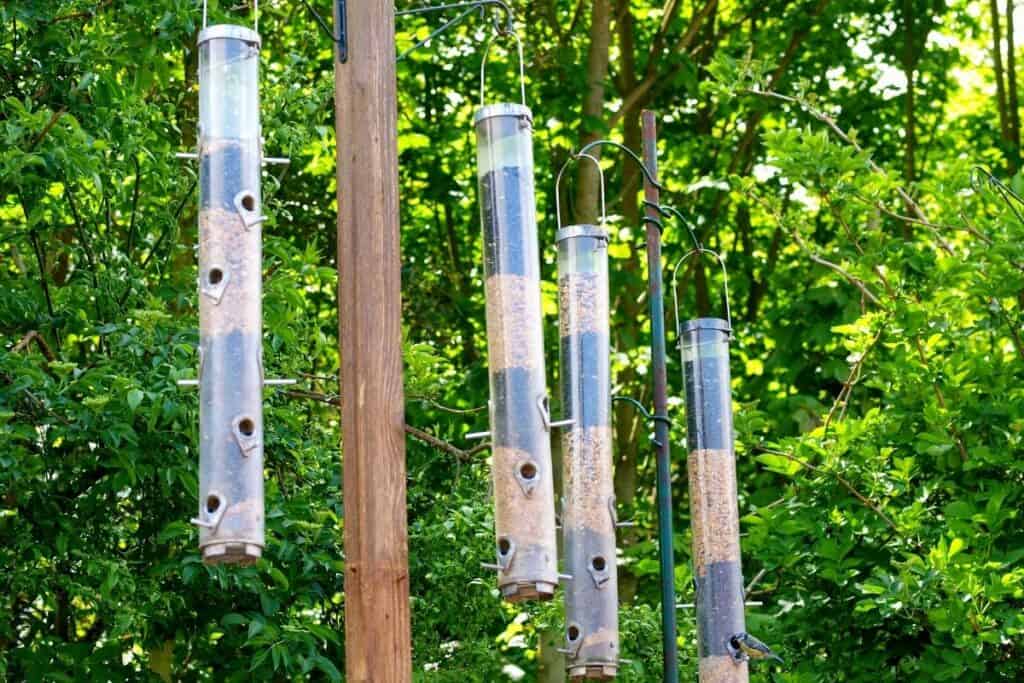
As mentioned in the previous point, each feeder can have its own specific species of birds that it will attract based on the type of feed it can contain.
This is where most people err in the bird feeding process. They only set up one feeder!
Of course, with just one feeder, you may see some success, but if you’re going to be feeding the birds anyway, put in some more effort to create a feeding station containing multiple feeders.
There’s actually an immense benefit to doing this. Here’s why:
- Birds tend to flock together, especially for flocking birds like starlings. By setting up multiple feeders, you’ll attract an entire flock of birds because there’s enough food to go around.
- You’ll attract a variety of species. It’s like providing a buffet for people with different food preferences. When birds of different species spot other birds feeding from a food source, they’ll also want in on the feast. From afar, you’ll basically be more discoverable by species that you may not have seen before!
17. You Are Feeling Birds The Wrong Type of Food
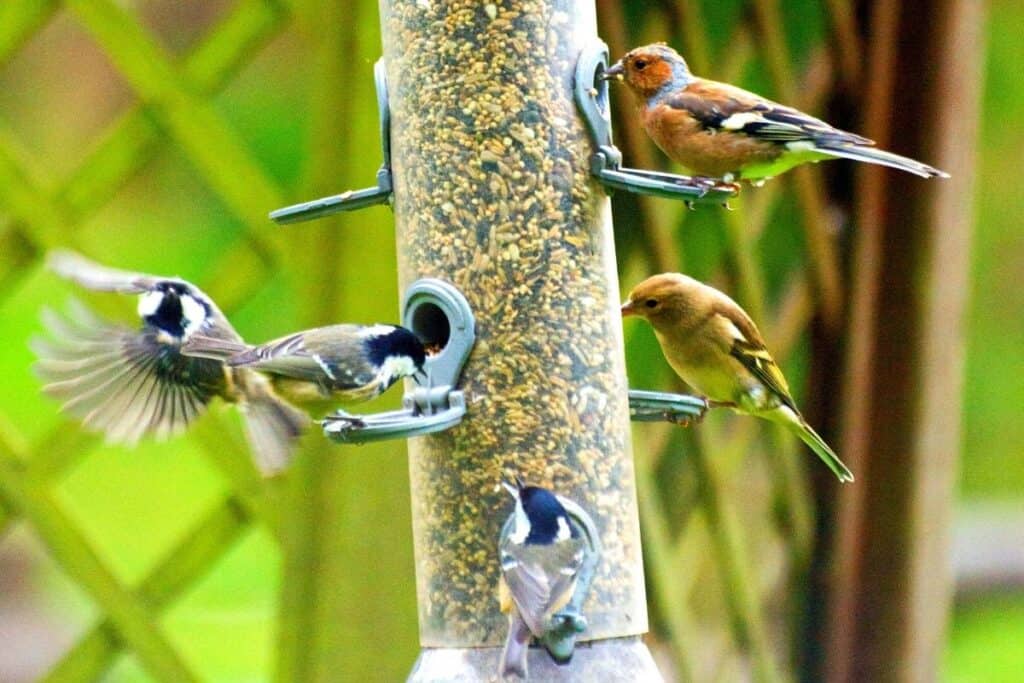
Stop feeding birds with so much human food!
If you keep feeding birds human food scraps from your kitchen like:
- Bread crumbs
- Fruit
- Seeds
- Nuts
Then it’s likely that you are encouraging more scavenger birds like crows, mynahs, sparrows, blackbirds, and Red-winged Blackbirds.
You’re attracting more of them into your yard and area by feeding them human food scraps.
Over time, you may eventually be feeding birds that do not really feed much from feeders!
If you want to attract smaller, more adorable birds, you need to feed them with the right type of bird feed!
It all starts with understanding that what you feed is what bird you attract!
Consider the following types of bird feed to fill up your feeders instead of human food scraps:
- Suet
- Black Oil Sunflower Seeds
- Peanuts
- Safflower Seeds
- Nyjer
- White Proso Millet
- Corn
- Red Millet
You may wish to read more about the abovementioned seeds from an article I found at The Spruce.
18. Your Bird Feed Became Moldy in the Bird Feeder
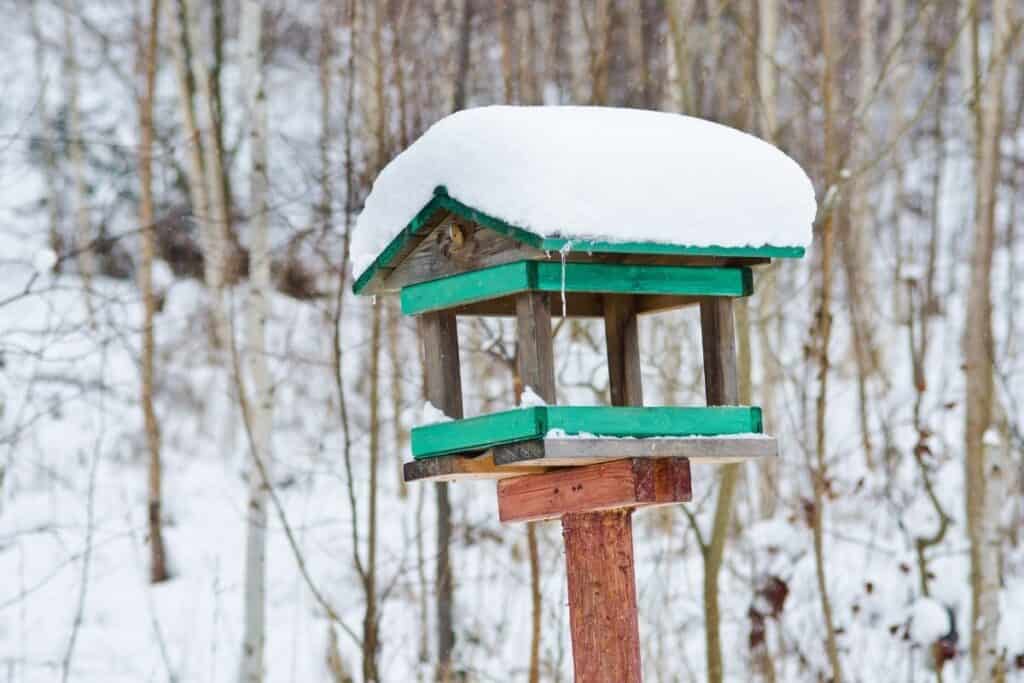
Bird feed can get moldy really fast, especially during the winter, when snow builds up and melts into water. Water that seeps into the bird feed can go bad easily.
However, the feeder itself can get really moldy during other seasons too. So do routinely check if your feeder looks really dirty, and make sure to clean it thoroughly!
Take note: mold builds up really quickly in sugar water in hummingbird feeders!
This is why hummingbird feeders MUST be cleaned fully every time the nectar is refilled. This can range between 2 – 5 days, depending on the climate. A hot climate warrants a higher frequency of refill as bacteria and fungi can grow faster.
To look out for mold, look for cloudiness in the water or specks of black mold.
If you’re unsure how to clean it, researchers have proven that this is the best way to clean a bird feeder:
Soak the feeder for a good 10 minutes in a diluted bleach solution for a period of one hour. Then put on gloves to scrub the feeder with a bottle brush. Allow to dry fully before hanging it up again.
Note: It’s important to put on gloves when cleaning the feeder because it may contain bacteria that may be harmful to humans too!
Then fill it up with fresh seeds!
19. Your Bird Feed is not Topped Up Regularly
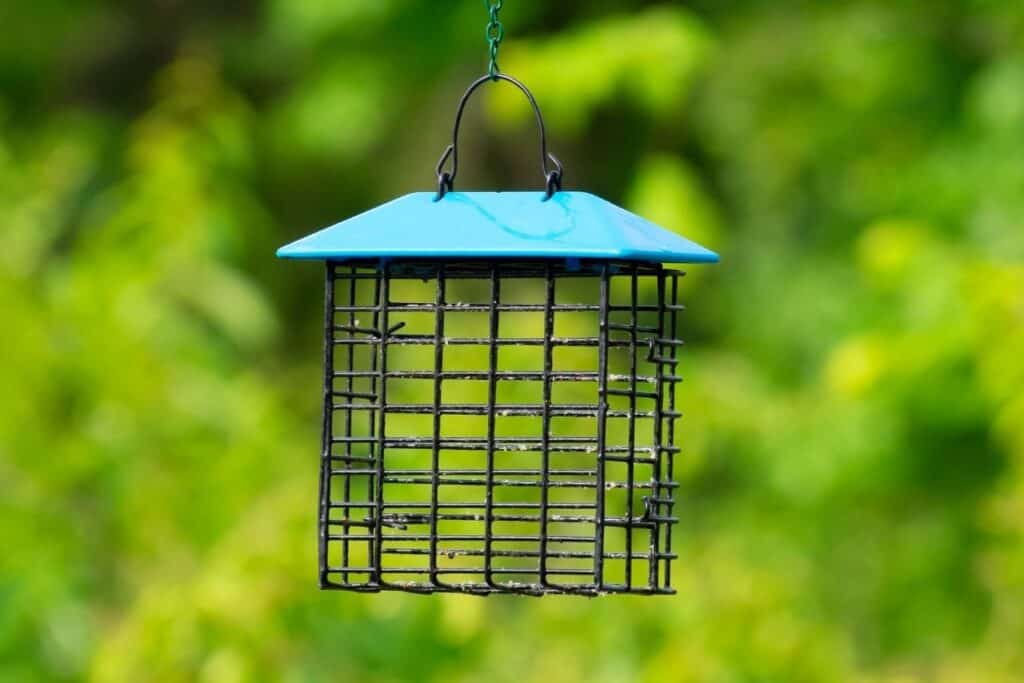
Bird feed should be topped up about once a week. However, this is a rough guideline for you to follow. If birds are consuming more quickly and it’s within your budget, then top them up as you go along.
If you find that your bird feed finishes up really quickly over one or two days, it could be that another animals are also eating from your feeder.
Squirrels, as mentioned in a previous point, are one of the most common animals to consume large amounts of seeds from feeders. Do take the necessary measures needed to keep them off your feeders! (refer to point no. 9)
It is possible that other types of wildlife consume the seeds. These can include deer, raccoons, rats, and chipmunks.
Here are methods to reduce the frequency of topping up your bird feed:
- Consider getting a larger feeder that can last a longer period. This ensures that they don’t empty out too quickly!
- Monitor your feeder through a camera at night. There may be nocturnal wildlife consuming your bird feeders. Consider using more tube feeders, which can work better than platform feeders in preventing other wildlife from accessing the seeds.
20. Your Bird Feed Has Gone Bad/Grown Old
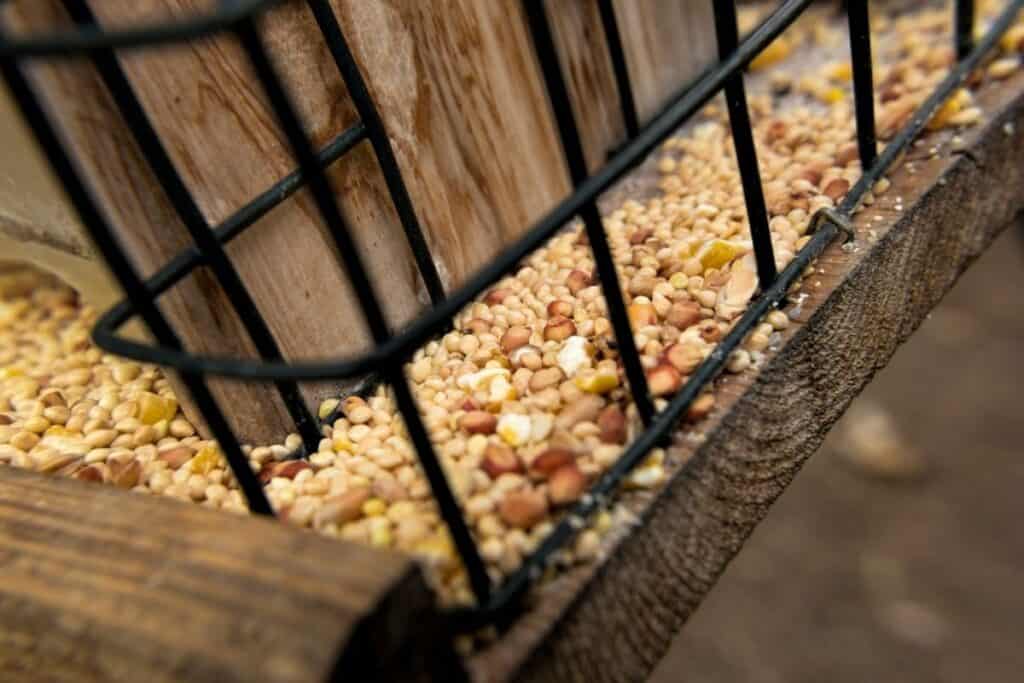
If you’ve left your bird feed out for quite a while, there’s a high chance that it may have gone bad!
If your bird feeder has seeds that are bad, birds know it and won’t eat it, which will likely cause them to avoid the feeder altogether in the future.
Here’s how often to change your bird feeder feed:
As a rule of thumb, you should change out your bird feed for new ones at least once a week. Ideally, you’ll also want to change all the bird feed present in the feeder to ensure you aren’t feeding any feed that has gone bad.
Take note that suet can go bad really fast in hot temperatures. Sugar water can go bad really quick too!
21. You Have Too Much of One Type of Bird Feed
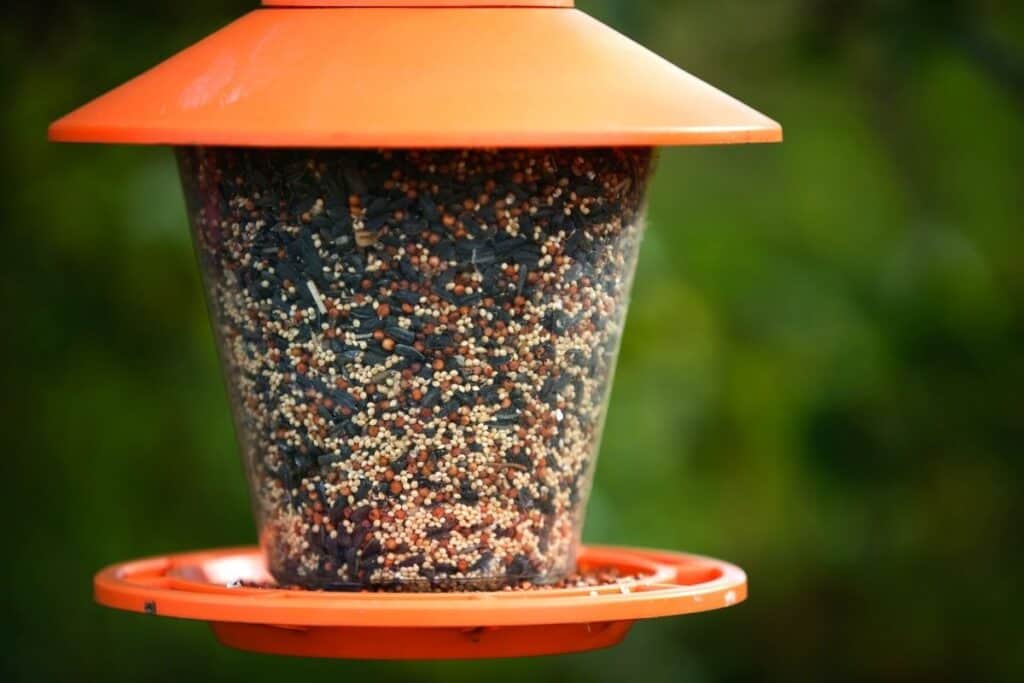
As mentioned in point 17, there are many different types of bird feed, each attracting different bird species.
If you have only one type of bird feed or too much of a single type, you’re potentially missing out on attracting other bird species that are in your area.
Also, it could just also happen that your area has birds that are not really attracted to that one particular type of bird feed that you’re feeding!
My recommendation is this: Fill up your multiple feeders with different types of bird feed and see which birds love more and double down on that particular one.
If you want to attract a few different bird species, it is important to diversify your bird feed!
Here’s a table for your reference:
| Bird Feed | Birds Species Attracted |
| Suet | Woodpeckers, wrens, flickers, nuthatches, and chickadees |
| Black Oil Sunflower Seeds | Finches, goldfinches |
| Peanuts | Jays, chickadees, nuthatches, and titmice |
| Safflower Seeds | Cardinals and other big-billed birds |
| Nyjer | Goldfinches, siskin, and redpolls |
| White Proso Millet | Doves, starlings, juncos, crows, pigeons, and sparrows |
| Corn | Doves, quail, and sparrows |
| Red Millet | Doves, juncos, sparrows, thrashers, wrens, cardinals |
If you ever need more information on the types of feed and even which to add to which feeder, check out this wonderful resource by FeederWatch!
22. You’re Using the Wrong Type of Bird Feed to Attract Birds in Your Region
Using the wrong type of bird feed can negatively affect how well birds are attracted to your yard and your feeder.
Here’s why:
The bird species that will visit your feeder varies depending on what state, country, or continent you live in.
As such, it is important to find out what birds are actually in your area, figure out what kind of bird feed they like, and put out bird feeders for that.
This strategy makes you much more likely to draw in more birds to your feeder!
Again, you can refer to the table below for a general guide on what birds eat and what kind of bird feed/seeds:
| Bird Feed | Birds Species Attracted |
| Suet | Woodpeckers, wrens, flickers, nuthatches, and chickadees |
| Black Oil Sunflower Seeds | Finches, goldfinches |
| Peanuts | Jays, chickadees, nuthatches, and titmice |
| Safflower Seeds | Cardinals and other big-billed birds |
| Nyjer | Goldfinches, siskin, and redpolls |
| White Proso Millet | Doves, starlings, juncos, crows, pigeons, and sparrows |
| Corn | Doves, quail, and sparrows |
| Red Millet | Doves, juncos, sparrows, thrashers, wrens, cardinals |
If you’d like more specific information on the bird species and their favorite feed, check out this link at FeederWatch, where they cover the different bird species.
You’ll want to use this alongside the merlin bird ID app to confirm the identification of birds when they come!

You should also check out this link where I got these above posters for free!
If you ever need more information on the types of feed and even which to add to which feeder, check out this wonderful resource by FeederWatch!
It will show you the common feeder birds based on your region, then show their favorite food type and feeders you can hang up to attract them!
23. Your Haven’t Been Feeding Birds in A Long Time
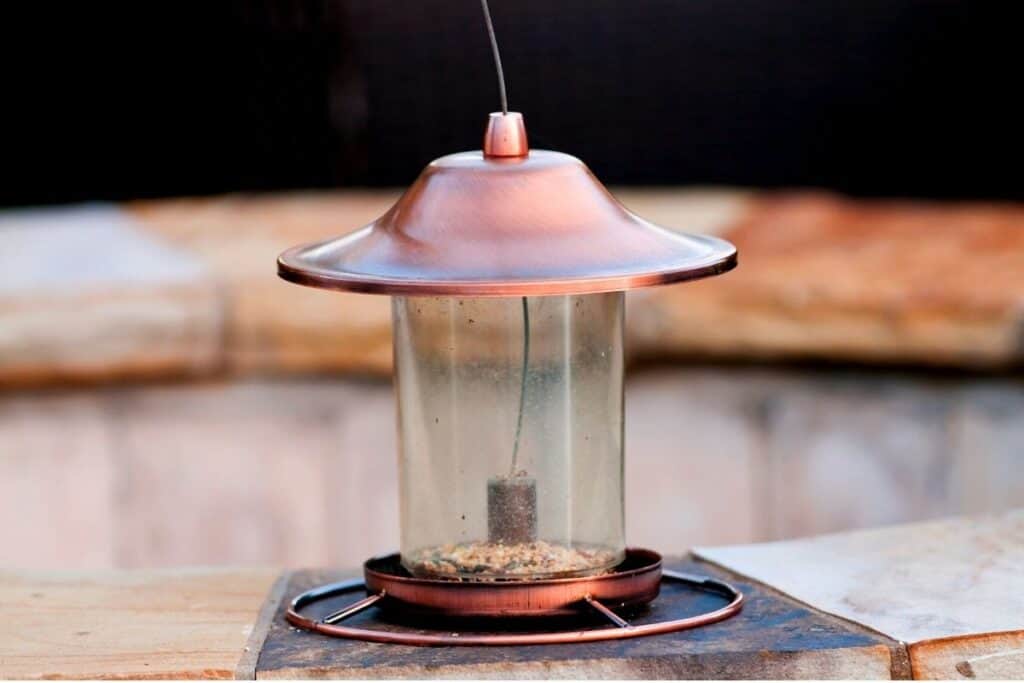
This reason is quite self-explanatory: maybe it’s been a long time since you last put out our bird feeders, so birds may not have noticed them going up again.
Maybe you’ve had your “glory days” and wondering why you can’t repeat the process again.
For birds to find out that there’s food at your feeder, you need time.
When setting up your feeders again, it’s like resetting the timer on how long it takes for them to find a feeder again.
24. You’re Using Chemical Insecticides or Fertilizers In Your Garden
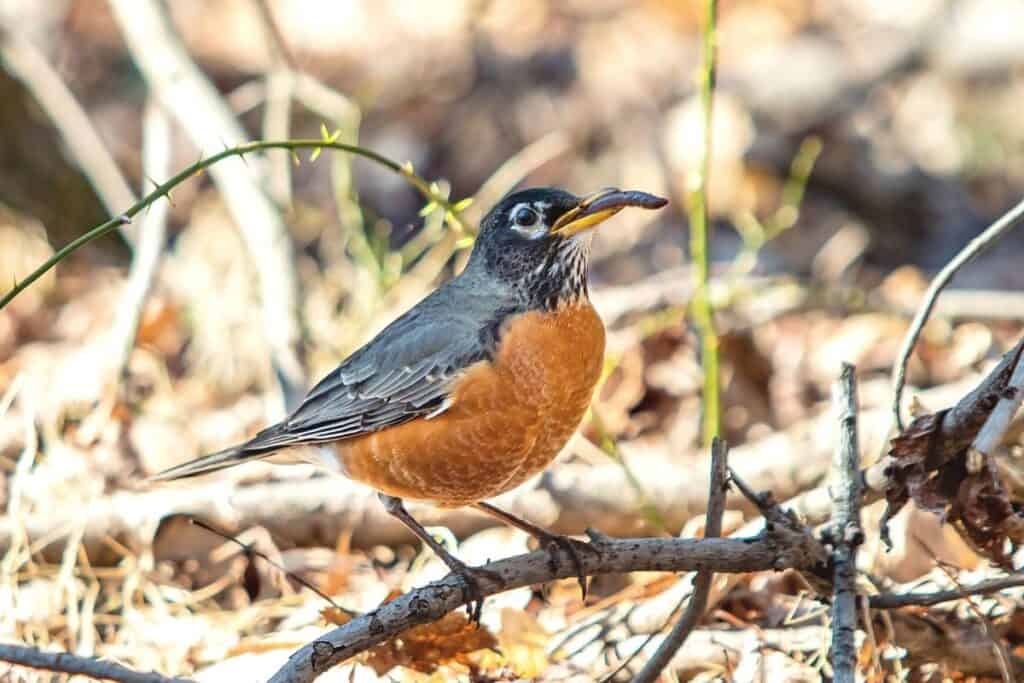
To attract more birds to your yard and to your feeder, you’ll need to have some natural food sources around too. Like bugs and insects.
So if you have been using chemical insecticides or fertilizers in your garden heavily, STOP using them!
Bugs are natural food sources that will organically lure the birds to come within the area and stop by your feeder.
Examples of birds that love to eat worms and bugs include robins, wrens, and many more!
Moreover, the usage of poison/pesticides to rid of pests can also cause harm to them when they accidentally consume them!
25. Your Backyard Has Too Much Human Activity
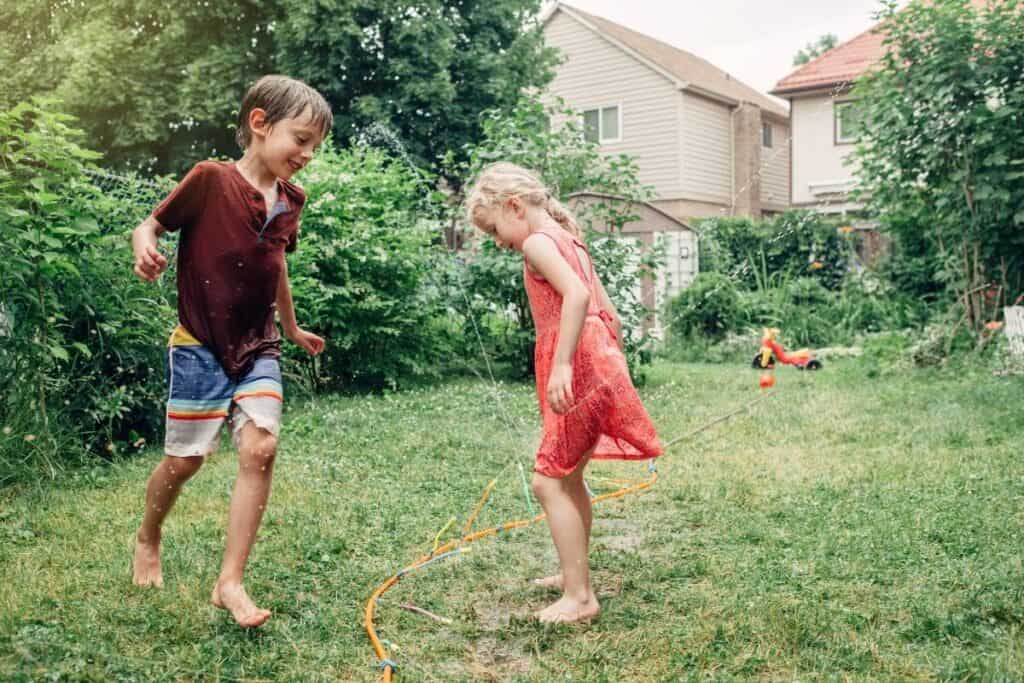
Feeders aren’t just standalone things in a backyard.
The general human activity present in the backyard determines how much freedom the birds can have to eat without any disturbances.
If you’re gonna be constantly staring them down or have kids run around the yard ever so often, it’s difficult for more skittish birds to approach your yard, let alone your bird feeder.
My recommendation: Give the birds some space to discover your feeder, then let them eat in peace. If you really want to observe the birds at a close distance, consider getting a trail camera or any camera that has Livestream capabilities.
That way, you can keep tabs on the birds at the feeder while maintaining your distance!
Check out this article where I review a few good trail cameras:
26. Your Backyard is Dominated by Your Pet Cat
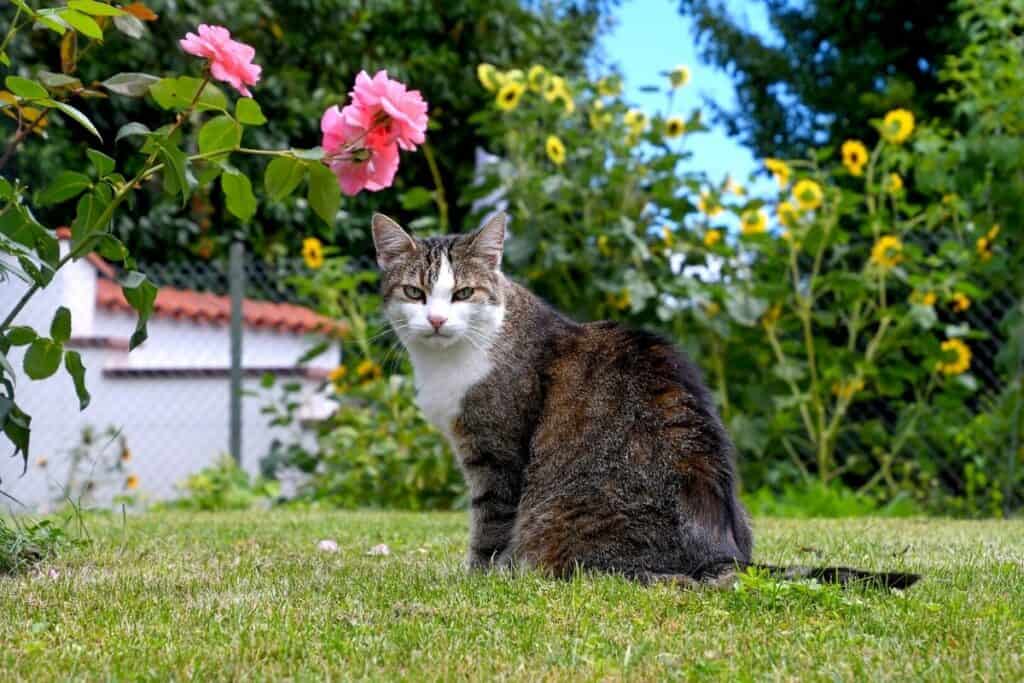
If you have a pet cat that roams around freely in your backyard, don’t expect birds to come close to your feeder!
According to Smithsonian Magazine, Americans own lots of cats: 86 million cats, with each household having a 33% chance of owning a cat. And about 1/3 of these cats are domestic cats that roam around freely outside the house.
These roaming cats are the problem.
Don’t get me wrong! I love cats, and they are great for admiring and cuddling. But the cats that roam freely often kill birds more often than you think.
According to scientists, free-ranging domestic cats kill up to 4 billion birds each year!
But sometimes, it’s just not your fault but a neighboring cat.
What you can do is ask for them to wear a cute bird-safe cat collar by Birdsbesafe!
These collars have striking colors that are very obvious to birds and allow them to fly away before they get hunted by a cat.
Check it out if you’re keen!
27. Your Neighbour Already Has a Successful Bird Feeder
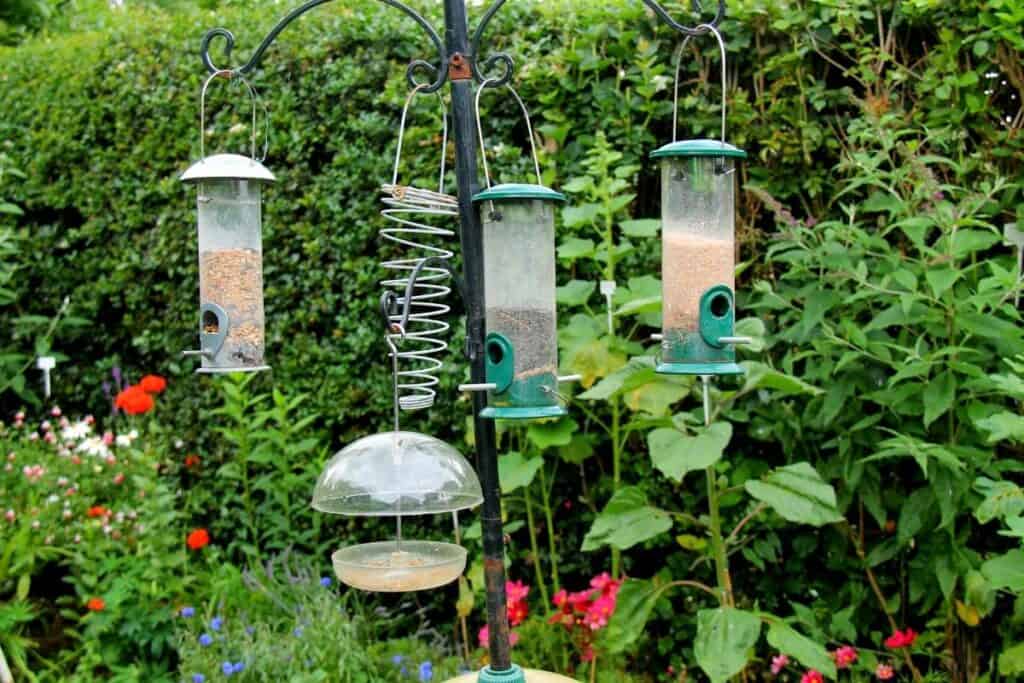
Sometimes it’s not your fault that you already have a huge bird-feeding competitor: your neighbor.
Picture this:
Your neighbor has already established a good feeding regime, a healthy balance of feeders for different bird species, and a flourishing backyard full of attractive facilities like a bird bath and so on.
If that’s the case, you’ll have no choice but to up your game and provide the same amount of value as your neighbor.
Although, I do foresee this being an advantage of having birds find your feeder faster than normal due to the close proximity of an already successful feeder in your neighbor’s yard!
However, you will probably find it hard to keep them coming back to your own yard if you don’t have the right amenities provided for them!
Like what I mentioned earlier in this article, you may want to purchase a bird bath or birdhouse to complement the feeders in your yard. I think that’ll really help you lots!
28. Competition Among Backyard Birds Caused Some to Leave
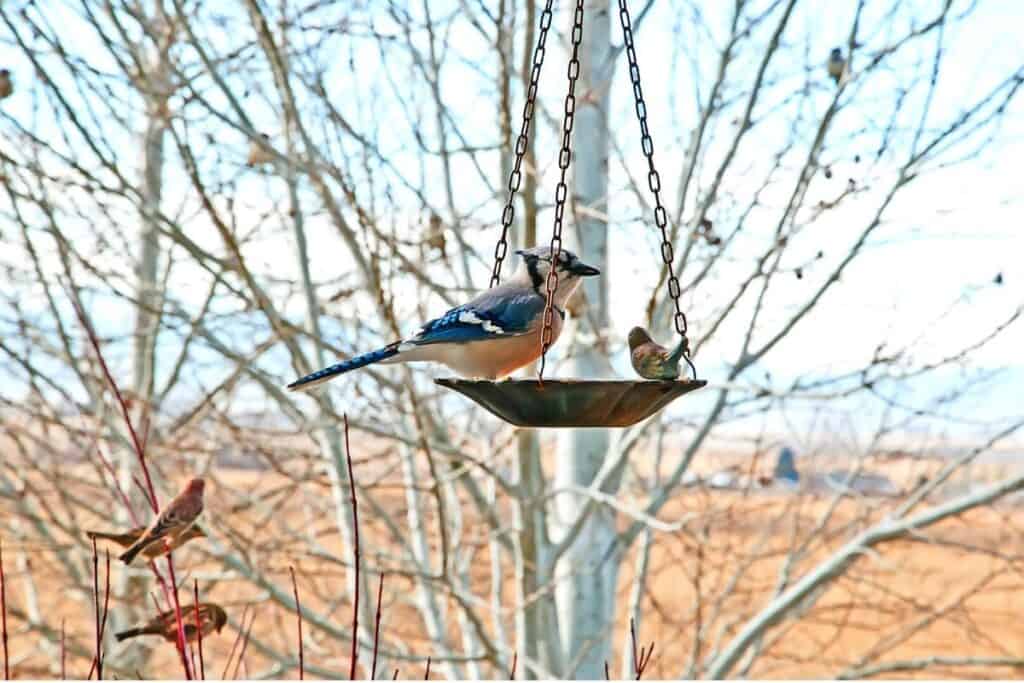
Even when feeding on a feeder, there is competition among the birds!
In fact, the larger birds tend to “bully” the smaller ones away from the feeder. As a result, some smaller ones may leave to find natural food sources somewhere else.
What you can do to prevent this is to have specific feeders that won’t allow the bigger backyard ones to dominate.
You can refer to point number 15 and 16 for more information!
29. Your Neighborhood Has Fewer Birds Than Normal
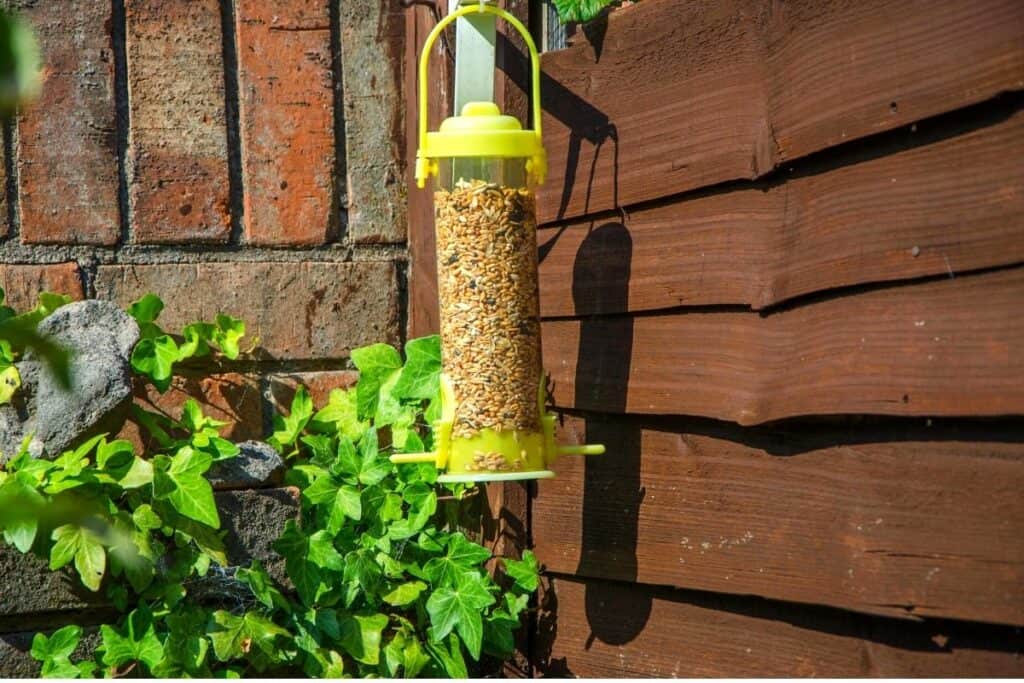
If all else fails, then could be just lesser birds in your neighborhood!
What you can do to figure this out is to ask a few neighbors around you if they are feeding any birds.
If they are, ask how many visit them and for tips to attract them to your region.
Bird feeding can feel like a very personal hobby, but there are lots of people around who share the same hobby!
Community is important in feeding them because it can get difficult at times.
Do make sure to join some Facebook groups, Telegram channels or Discord groups. These all help you get your questions answered by those that have gone before you.
Most of them would be glad to help!
To get you started, here are some Facebook groups that I recommend:
Final Thoughts
Now that you know why wild birds won’t come to your feeder, act on these now! Then you’ll reap the rewards of your efforts.
I wish you all the best in your bird-feeding journey.
Happy birding!

Justin Chia
Justin is the founder and author of Birding Outdoors. He is a Nanyang Technological University (NTU) alumnus with a Bachelor of Biological Sciences and a former data analyst.
Now, Justin runs the Birding Outdoors blog full-time, hoping to share his deep love for birds, birding, and nature with others.
To unwind, Justin enjoys gaming and reading.

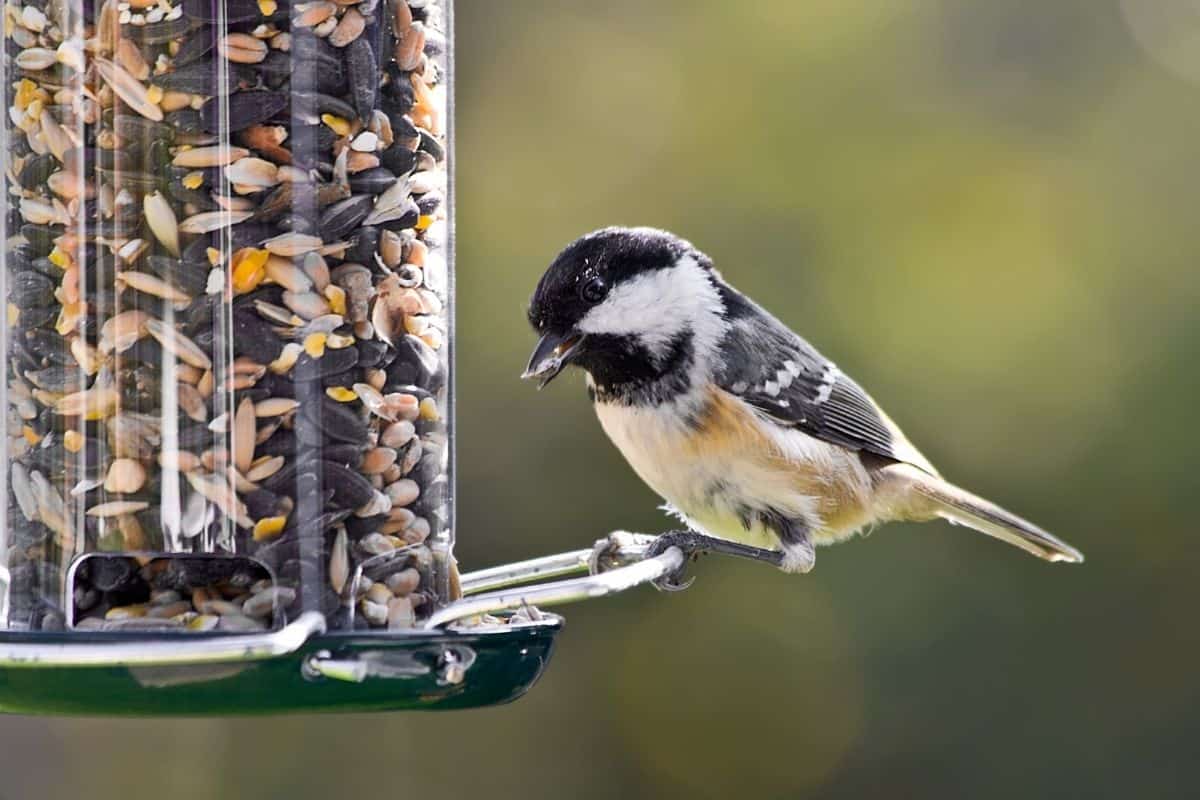
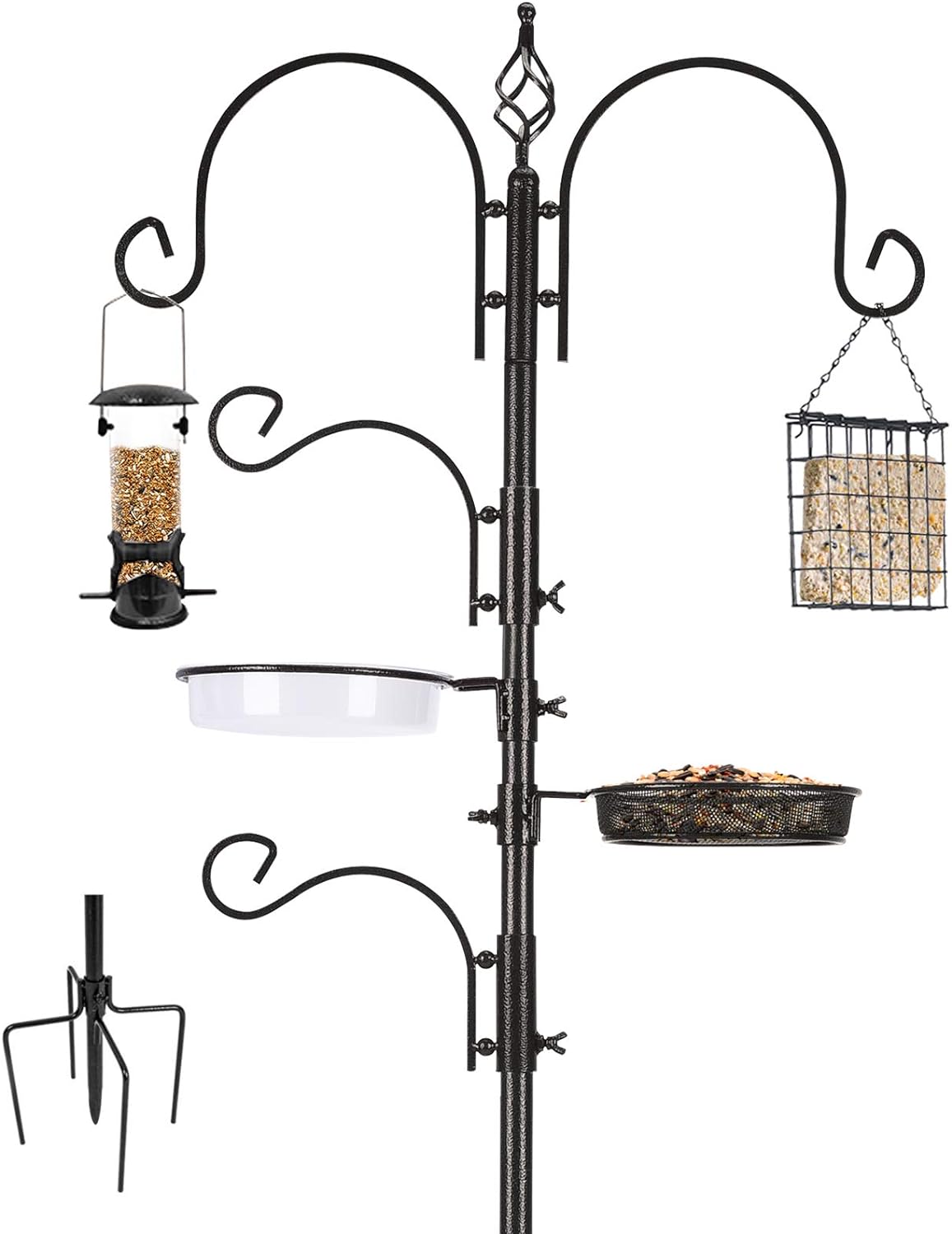

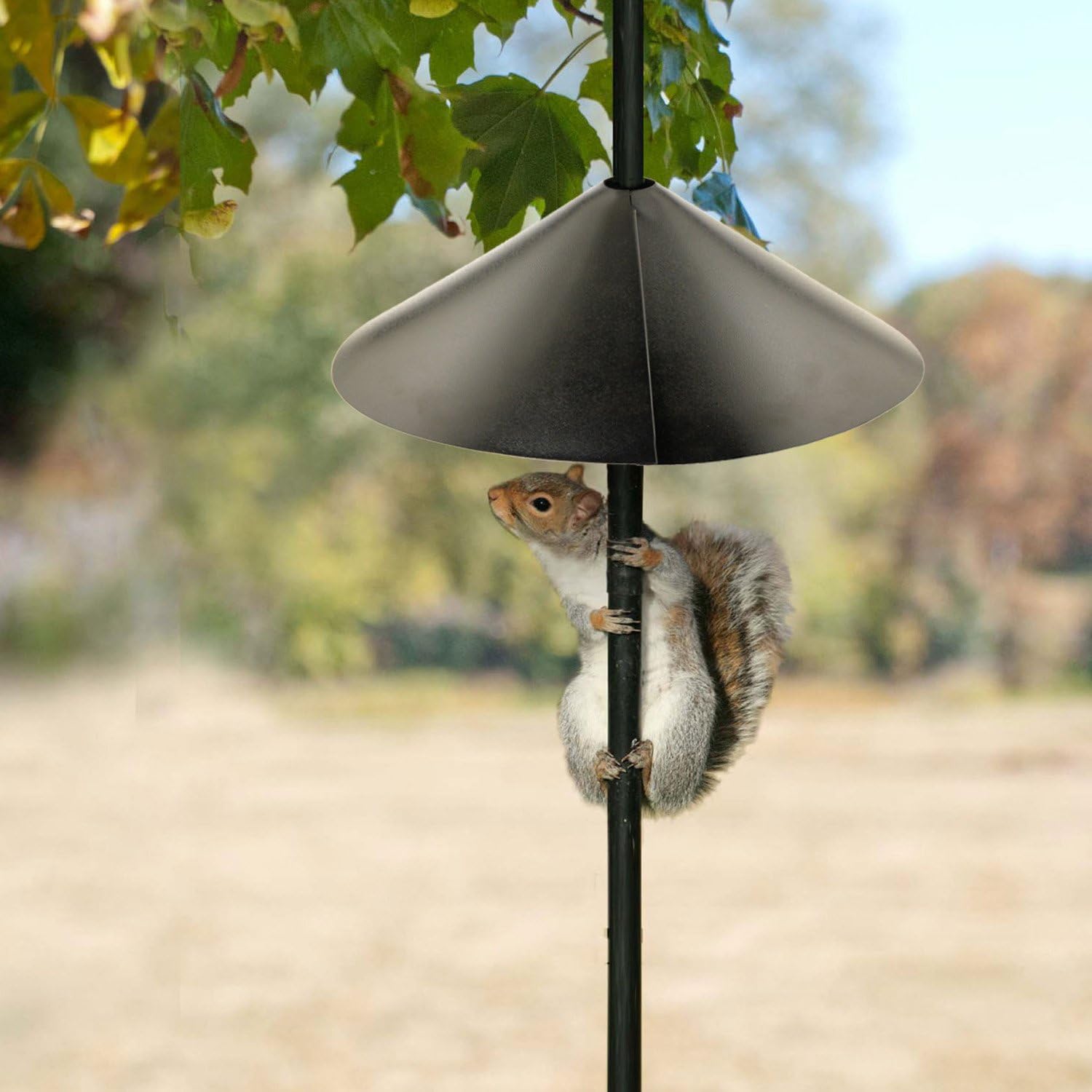
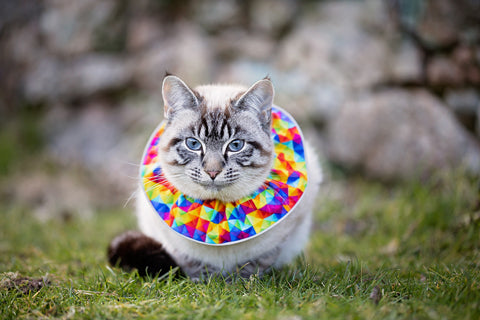
![Do All Baby Birds Survive In Nests? [ANSWERED! + FAQs]](https://birdingoutdoors.com/wp-content/uploads/2021/06/bird-4299034_1280-768x512.jpg)
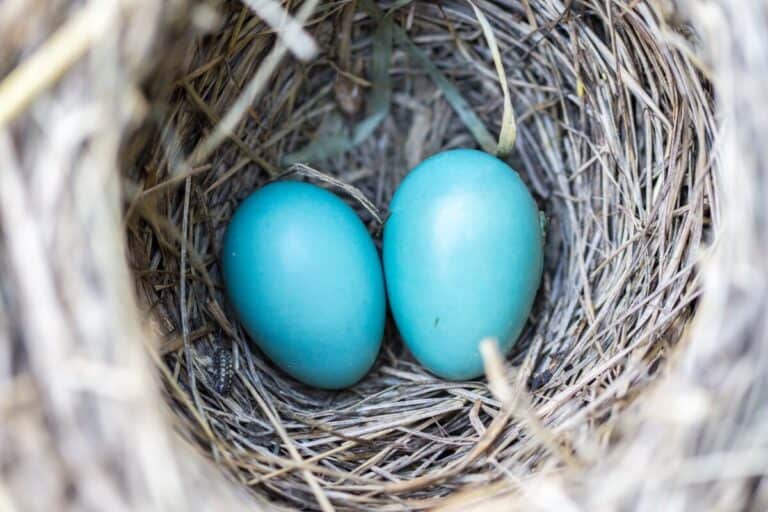
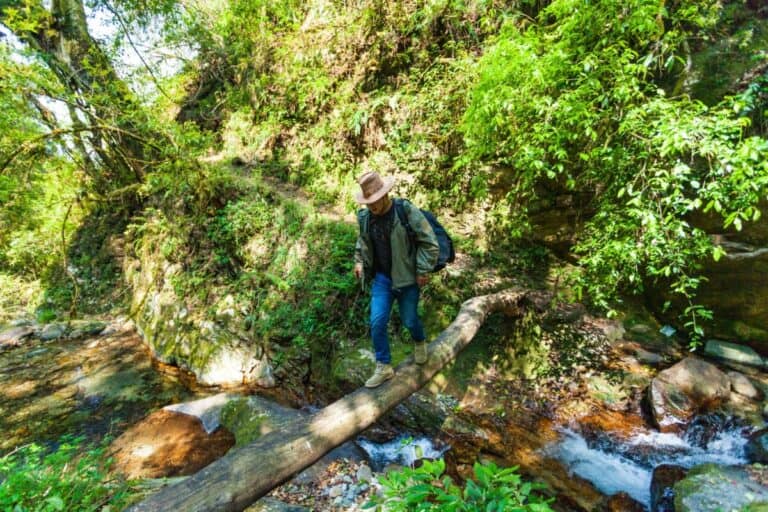

![What Is A Lifer In Birding? [ANSWERED! + Usage Examples]](https://birdingoutdoors.com/wp-content/uploads/2021/03/pexels-photo-6272236-768x512.jpeg)
